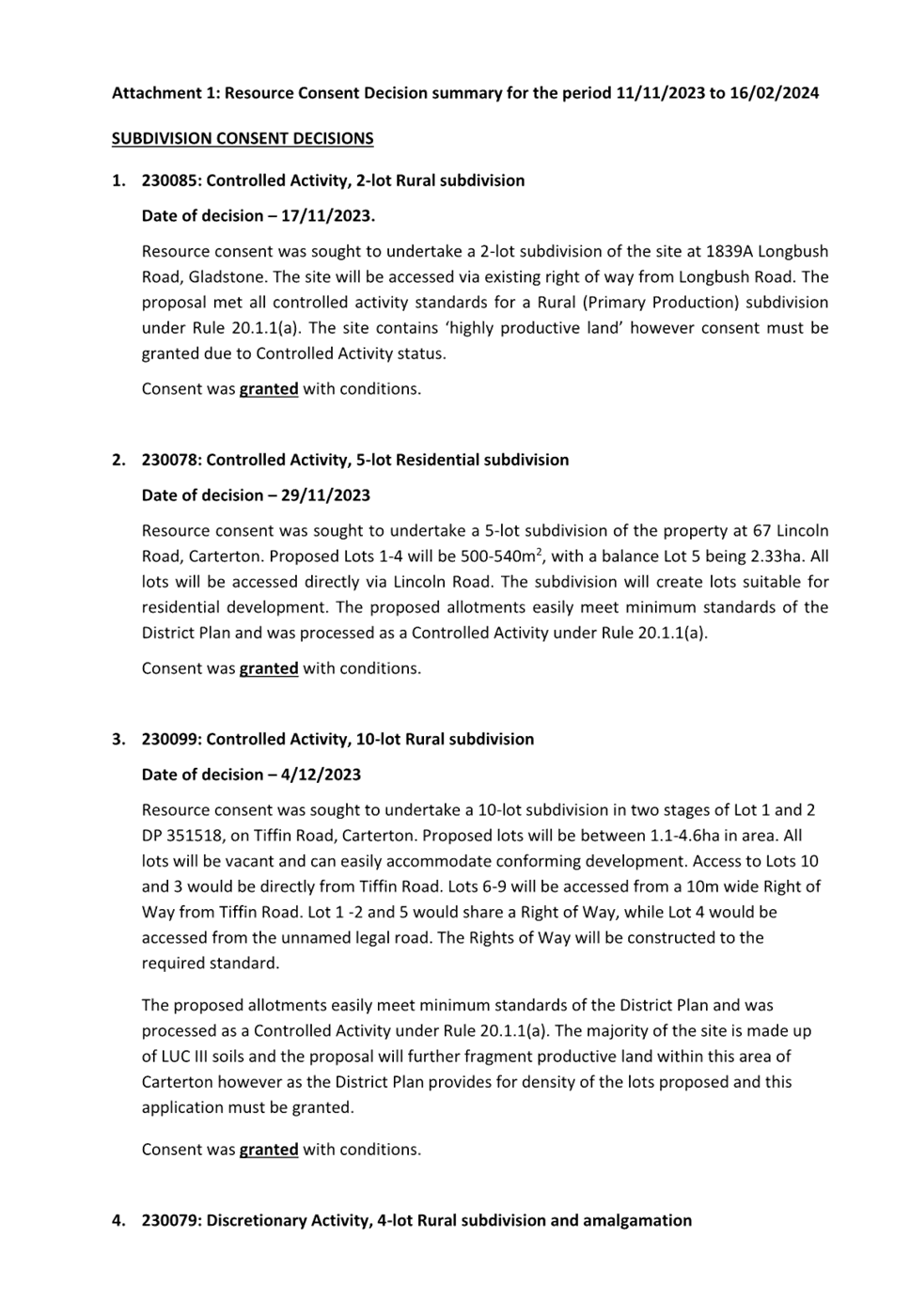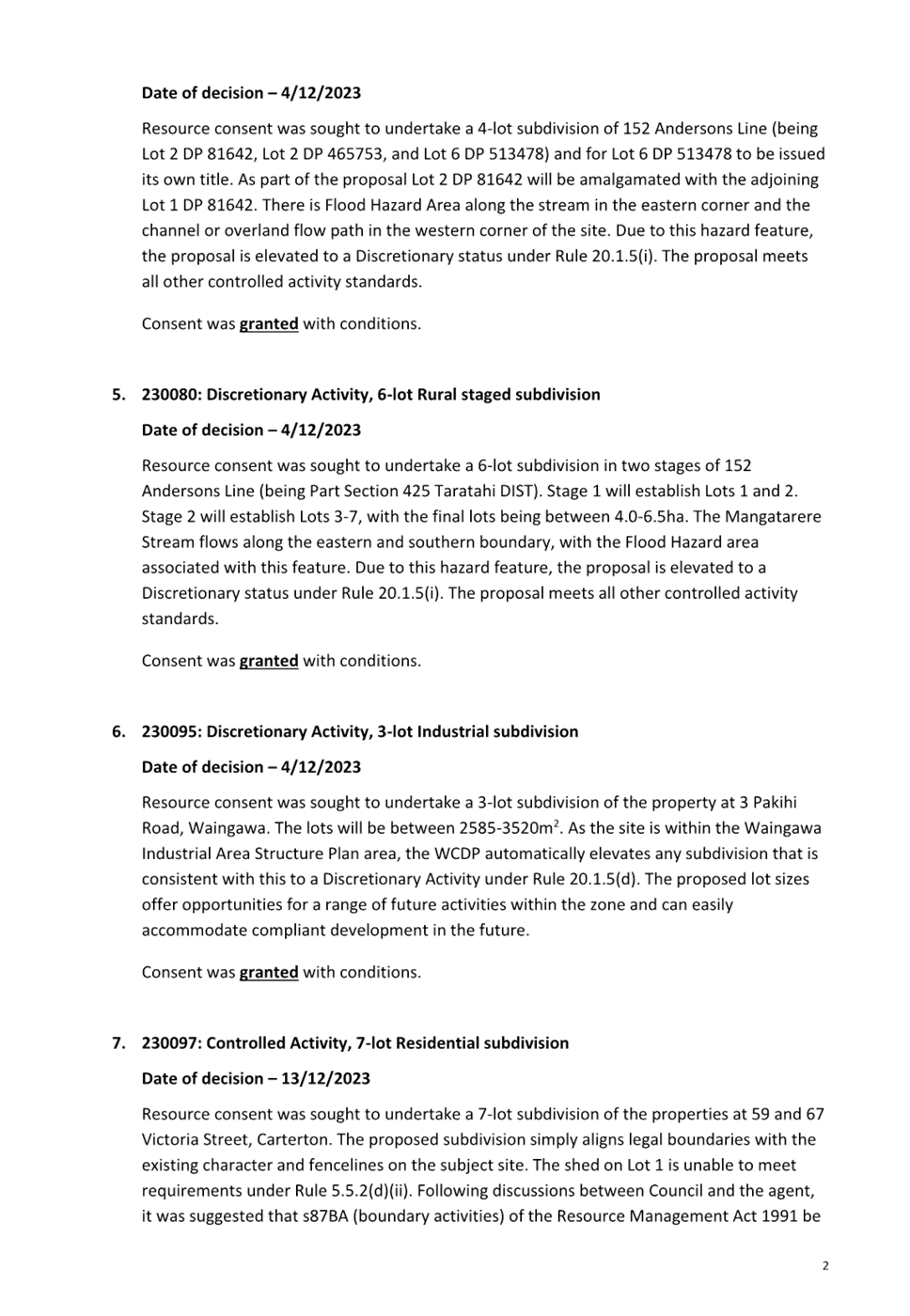|

|
|
AGENDA
Policy and Projects Committee meeting
|
|
Date:
|
Wednesday, 28 February
2024
|
|
Time:
|
9:00 am
|
|
Location:
|
Carterton Events Centre
50 Holloway St
Carterton
|
|
Cr S Cretney (Chair)
Cr S Gallon (Deputy
Chair)
Mayor R Mark
Deputy Mayor D
Williams
Cr B Deller
|
Cr R Cherry-Campbell
Cr L Newman
Cr S Laurence
Cr G Ayling
R Smith - Hurunui-o-Rangi
Marae representative
|
|
Policy
and Projects Committee meeting Agenda
|
28
February 2024
|
5 Confirmation
of the Minutes

5.1 Minutes
of the Policy and Projects Committee Meeting held on 22 November 2023
1. Recommendation
1. That
the Minutes of the Policy and Projects Committee Meeting held on 22 November
2023 are true and correct.
File
Number: 374322
Author: Robyn
Blue, Democratic Services Officer
Attachments: 1. Minutes
of the Policy and Projects Committee Meeting held on 22 November 2023
|
Policy
and Projects Committee meeting Minutes
|
22
November 2023
|

MINUTES OF Carterton District Council
Policy and Projects Committee meeting
HELD AT THE Carterton Events Centre, 50
Holloway St, Carterton
ON Wednesday, 22 November 2023 AT
9:00 am
PRESENT: Cr Steve Cretney (Chair), Cr Steve Gallon (Deputy Chair),
Mayor Ron Mark, Deputy Mayor Dale Williams, Cr Brian Deller, Cr Robyn
Cherry-Campbell, Cr Lou Newman, Cr Steve Laurence, Cr Grace Ayling (via
videoconference from 9.15 am)
IN ATTENDANCE: Staff
Geoff Hamilton (Chief Executive), Solitaire Robertson
(Planning and Regulatory Services Manager), Johannes Ferreira (Infrastructure
Services Manager), Elisa Brown (Communications and Engagement Manager), Marcus
Anselm (Communications and Engagement Coordinator) via videoconference, Robyn
Blue (Democratic Services Officer)
1 Karakia
Timatanga
The meeting opened with a karakia
by Cr Steve Cretney.
2 Apologies
MOVED
That
apologies be received from Mayor Ron Mark and Ra Smith, and Grace Ayling for
lateness.
Cr S Cretney / Deputy Mayor D
Williams
CARRIED
3 Conflicts
of Interests Declaration
There were no conflicts of
interest declared.
4 Public
Forum
There was no public forum.
5 Confirmation
of the Minutes
|
5.1 Minutes
of the Policy and Projects Committee Meeting held on 4 October 2023
|
|
MOVED
1. That the
minutes of the Policy and Projects Committee Meeting held on 4 October 2023
are true and correct.
Cr R Cherry-Campbell / Deputy
Mayor D Williams
CARRIED
|
6 Reports
|
6.1 Road
and Street Naming Policy
|
|
1. Purpose
For the Committee to adopt the updated Road and Street
Naming Policy to reflect the addition of culturally significant names.
|
|
MOVED
That the Committee:
1.
Receives the report.
Cr S Laurence / Cr L Newman
CARRIED
2. Adopts the updated
Road and Street Naming Policy in Attachment 1 with the amendments as
noted.
Cr S Cretney / Cr B Deller
CARRIED
|
|
6.2 Resource
Consent Update
|
|
1. Purpose
The purpose of this report is to update the Committee on
the resource consents issued since the previous update.
|
|
MOVED
That the Committee:
1. Receives
the report.
Cr S Cretney / Cr R
Cherry-Campbell
CARRIED
|
|
6.3 Major
Projects update
|
|
1. Purpose
To update the Committee on the progress of major
projects.
|
|
MOVED
That the Committee:
1. Receives
the report.
Cr S Cretney / Cr S Laurence
CARRIED
|
7 Karakia
WhakamUtunga
The meeting closed with a karakia
by Cr R Cherry-Campbell
The Meeting closed at 9.45 am
Minutes confirmed:
……………………………………
Date: ...................................................
|
Policy
and Projects Committee meeting Agenda
|
28
February 2024
|
6 Reports

6.1 Decision
on English Oak - Carrington Park
1. Purpose
For the Committee to
decide the outcome of the English Oak at Carrington Park.
2. Significance
The
matters for decision in this report are not considered to be of significance
under the Significance and Engagement Policy.
3. Background
From
our research and historical reports, it is believed the English Oaks at
Carrington Park, were planted on 15 July 1904 as part of the Arbour Day
event. At this event approximately three hundred trees were planted in
Carrington Park by school children, the Mayor, councillors, and those who
volunteered to assist.

From
those plantings only 34 trees remain. These thirty-four 122 year old
trees have local historical value being part of a significant community
event.
Ka
Pai Carterton contracted Paper Street Tree Company to provide a Tree
Constraints Plan for the trees that stand within Carrington Park, as part of
the design work for the proposed Carrington Park upgrade.
This
report has provided us with valuable insight into the management plan for these
historical trees.
Out
of the 34 historical trees, 25 show a history of canopy loss from overextended
limbs. This suggests that limb failure is likely in the foreseeable
future, and the history of failure shows that is has also been the case to
date. As trees are in a group, where limbs are lost, adjacent limbs
become more exposed to increased loads. Therefore, a higher proportion of
limb loss will contribute to propensity for further limb failure.
Intervention is required to ensure the appropriate level of duty of care is
administered, and important community assets are preserved.
The
Parks and Reserves team is working with an arborist to ensure a Tree Management
Plan is in place. This will include an inspection regime, specifications for
the work, management recommendations with priorities as to what order the works
are to be carried out, and protection guidance for any development works.
However, we envisage that with the age of these trees that we are going to
start seeing significant issues appearing.
4. Discussion
For
the purpose of this report, we will specifically be discussing the English Oak
that is between the skate park and the bike track:





The
tree in question has been assessed by two professional arborist experts who
have both described the tree as having structural integrity issues which have
compromised its form, health and potential longevity.
The
initial survey conducted by Paper Street Tree Company notes its condition was
assessed and rated as having a 76% health rating and a 70% structural rating.
Within the structural rating mechanical weaknesses were identified where the
failure of 25% - 50% of the tree is foreseeable. Its value at the time of assessment
was $68,932.00 and noted to be decreasing.
Also
noted in their report was that the tree protection zone (TPZ) for this tree has
been compromised (with hard surface encroachment) any further development
within the TPZ would adversely affect the ongoing health of the tree.


The
Skate Park Group is currently undertaking their design work for the development
of a new skate park (which will sit along side the Ka Pai Carrington Park
detailed design). The Skate Park group had requested we consider removing
this tree. At this time Officers advised that tree removal would not be
an option, however we would seek an additional report to address the remedial
work.
An
additional report was undertaken from Wairarapa Treescaping on 14 November
2023. Their assessment supported the report from Paper Street Tree
Company and recommended we undertake the remedy and maintenance works –
specifically on the northern structural limbs overhanging the bike track,
including a canopy lift over the skate park area to counterbalance any remedial
works.
As
recommended by both reports maintenance work was undertaken to remedy the
immediate concerns. Through this maintenance work further structural and
limb dieback issues were identified. The revised recommendations from the
arborists are that:
· They do not
believe formative pruning is required due to the severity of the structural
integrity.
· Removing these
structures will lose approximately 35% (if not more) upper canopy and will have
a poor amenity appeal/value.
· With the tree
situated where it is, and the new hazards now identified, the view of the
arborists is that the removal of the English Oak tree would be the best option
due to safety reasons.


This
is likely to be an ongoing challenge with the remaining Oak trees in Carrington
Park. The English Oaks have grown rapidly in New Zealand’s more
temperate climate. At 122 years old they are some of the oldest Oak trees
in the Wairarapa. We are now discovering the fast growth suggests the
trees are more prone to heavy limb failure. We should anticipate these
symptoms may also appear in other Carrington Park Oaks.
5. Options
Option
1 – undertake pruning of the tree,
understanding this will lose approximately 35% (if not more) of the
upper canopy and have a poor amenity appeal/value. This does not guarantee the
future survival of this tree and ultimately could result in the health of the
tree continuing to decrease, with further structural maintenance
required.
Option
2 – removal of this tree as is now
recommended by the arborists. If this option is adopted, the wood will be
reutilised – sold or donated to local organisation(s) for re-use in
manufacturing or repairing timber furniture and products. Seedlings from
this particular tree are already being grown and will be planted at a more
suitable location once at an appropriate size.
6. NEXT
STEPS
Next
steps are dependent on the decision on the options. If option one is
preferred, officers will action the pruning works.
If Option
2 is preferred, officers will action the tree removal, noting communication
will be undertaken with the wider community of the works to be
undertaken.
7. CONSIDERATIONS
7.1 Climate change
It is
noted in the Paper Street Tree Company report that climate change predictions
for the region are likely to have an impact on species as climate is likely to
become more favourable for Mediterranean species (e.g. Turkey oak). Therefore,
maintaining and improving tree resilience will be important for long-term
retention (e.g. maintaining and allowing for mulched surfaces).
7.2 Tāngata whenua
Tāngata whenua have not had input into
the decisions of this report.
7.3 Financial impact
Both
options will be managed within existing Parks tree maintenance budgets.
7.4 Community Engagement requirements
Communication
on the decision will be shared out to the community.
7.5 Risks
Risk to public safety – doing
nothing is not an option for this tree. There is a 25 – 50%
likelihood of mechanical weakness.
Risk to public perception –
it is noted that the decision to remove this tree may cause public
concern. We will attempt to mitigate this through our communications,
press releases and engagement with park users.
7.6 Wellbeings
Social
The
trees are a much-loved asset of Carrington Park, and as noted above the trees
have local historical value being part of a significant community event.
Seedlings from this tree will be planted in more suitable locations around the
park, once big enough.
8. Recommendation
That the Committee:
1. Receives
the report.
2. Agrees
to Option 1, undertake pruning of the tree.
OR
3. Agrees
to Option 2, removal of the tree as recommended by the
arborists.
File
Number: 386097
Author: Glenda
Seville, Community Services Manager
Attachments: Nil
|
Policy
and Projects Committee meeting Agenda
|
28
February 2024
|

6.2 Consents
update
1. Purpose
To update the Committee on the consents that are
currently progressing and highlight any risks for the other current consents.
To update the Committee on the Draft water
management plan that needs to accompany the Kaipatangata consent renewal
application.
2. Summary
The main consents
currently being worked on are the water race renewals and the Kaipatangata
water take consent.
A number of expired
consents have been on-hold pending further information, such as the landfill
consent while council decides the sludge disposal route.
3. Consents
The waters team manage
8 different consents these are summarised in the table below:
|
Consent
|
Expiry
|
Status
|
Risks
|
|
Kaipatangata Surface
Water Take
|
2013
|
2012 application
on-hold, reapplying with updated information for the natural resources plan
|
Low flow restrictions
Request 20 years
|
|
Carterton Landfill
|
2016
|
2014 Application
on-hold, providing further information for sludge disposal options
|
Restrictions of sludge
disposal
Unknown risk for
unlined cell and what may be required for monitoring.
|
|
Frederick St
groundwater take
|
30/9/2034
|
Current
|
Nitrate levels for
drinking water
|
|
Taratahi Water Race
|
30/6/2023
|
2023 application
– public notification expected soon
|
Restriction during low
flow, amount of monitoring required
Requesting 20 years,
but may not get this
|
|
Carrington Water Race
|
30/6/2023
|
|
Waingawa swamp cleaning
|
3/9/2023
|
Expired, included in
the Water race consent application
|
|
|
Wastewater discharge
|
17/1/2053
|
Current; multiple
consents
|
Capacity for population
growth
|
|
Stormwater
|
15/8/2027
|
Current; Monitoring
consent to create stormwater management strategy
|
Roading run-off
treatment
|
A draft CDC Water Demand Management Plan is attached
for consideration by the Committee. This needs to accompany the
Kaipatangata consent renewal application.
4. REnewal
Progress
There are currently three
consents that are in different stages:
· A priority is the
water race consents relating to responding to section 92 request for
information. Public notification is expected to be in the next couple of
months, but we will try to work with stakeholders to progress this. For
example, initial discussions with Fish and Game and Iwi have been positive.
· The updated
application for the Kaipatangata has been on hold since 2015 while different
strategies developed by Council on use of Frederick St Water Treatment Plant
and the Kaipatangata supply. These were included in the considerations in the
alternative water supply project.
· Landfill consent
for the closed landfill which is the monitoring of the groundwater around the
site.
4.1 Kaipatangata
Water Take Renewal
The application has
been updated to reflect the updated natural resource plan which was finally
finalised last year. NRP (operative) version requires consideration of the
health needs of people for low flow conditions and a water management plan to
be developed.
The application will
be resubmitted by March, and then it is likely to go to public consultation. A
draft water demand management plan is attached to the report.
Budget: $384,664 was
transferred for the Alternative water source, of which $185,677 was available
for consultant review and stakeholder engagement
4.2 Water
Race renewal
A response to the
section 92 information request was sent to Wellington Regional Council in
February.
The application will
be resubmitted by March, and then it is likely to go to public consultation.
Budget: $326,864 of
which $39,042 was unallocated for stakeholder engagement and the
hearing/negotiation process. The actual cost during this period is unknown and
a risk.
4.3 Landfill
Renewal
The initial
application for the landfill (discharge of stormwater) was included as part of
the wastewater treatment plant renewal, however delay of the pond desludging
has resulted in this being put on hold.
The application will
be discussed with Wellington Regional Council in March, with the update of
plans for the desludging projects in the LTP, condition on the public
consultation.
Budget: There is no
specific budget for the consent, however $54,000 is available for the transfer
station facility, but the reports have been previously included in the
wastewater treatment budget due to the main use will be sludge disposal.
5. Recommendation
That the Committee:
1. Receives
the report.
2. Notes the Draft CDC
Water Demand Management Plan.
File
Number: 385410
Author: Lawrence
Stephenson, Waters Operations Manager
Attachments: 1. CDC
Water Demand Management Plan 2024 ⇩
|
Policy
and Projects Committee meeting Agenda
|
28
February 2024
|



















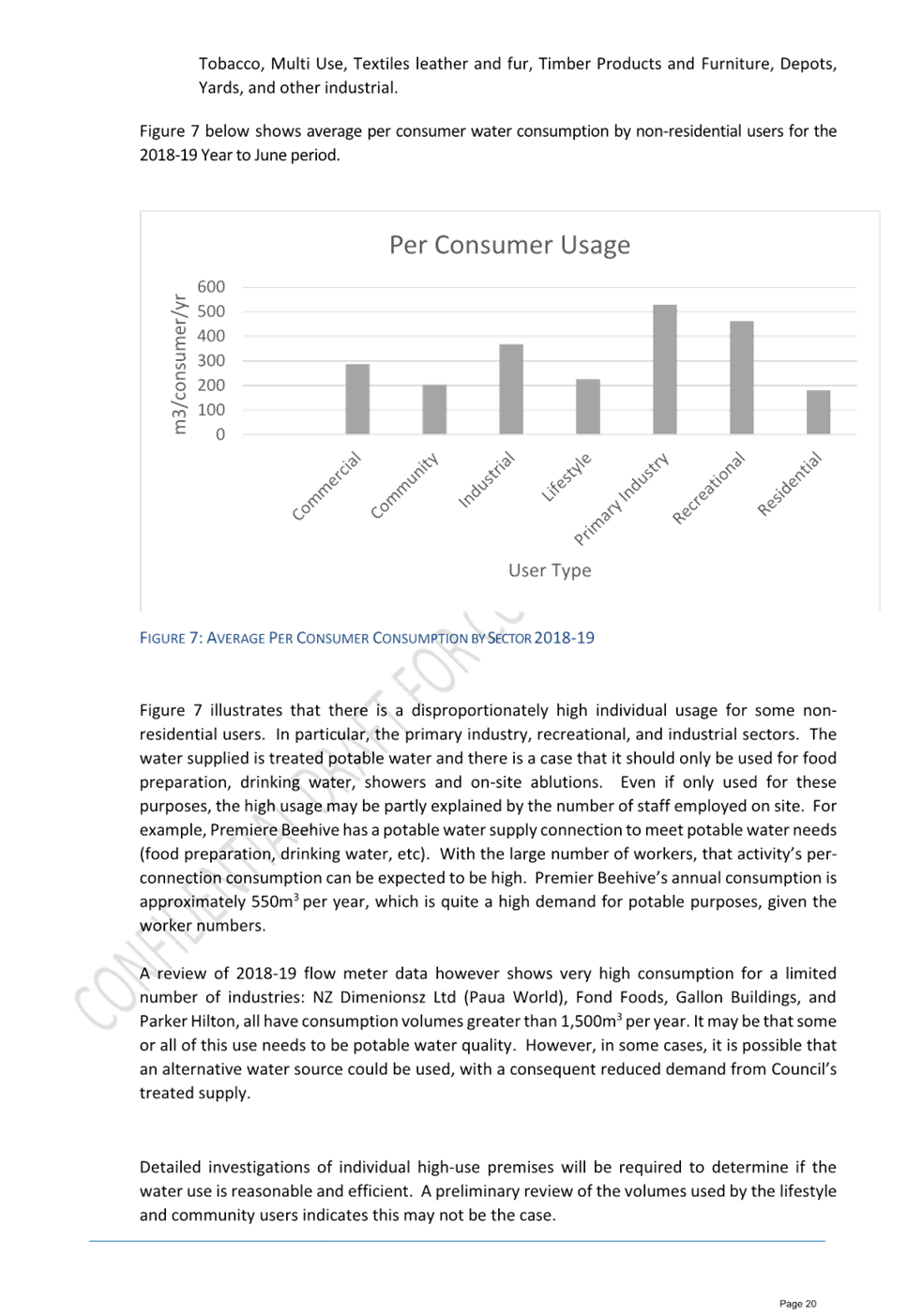
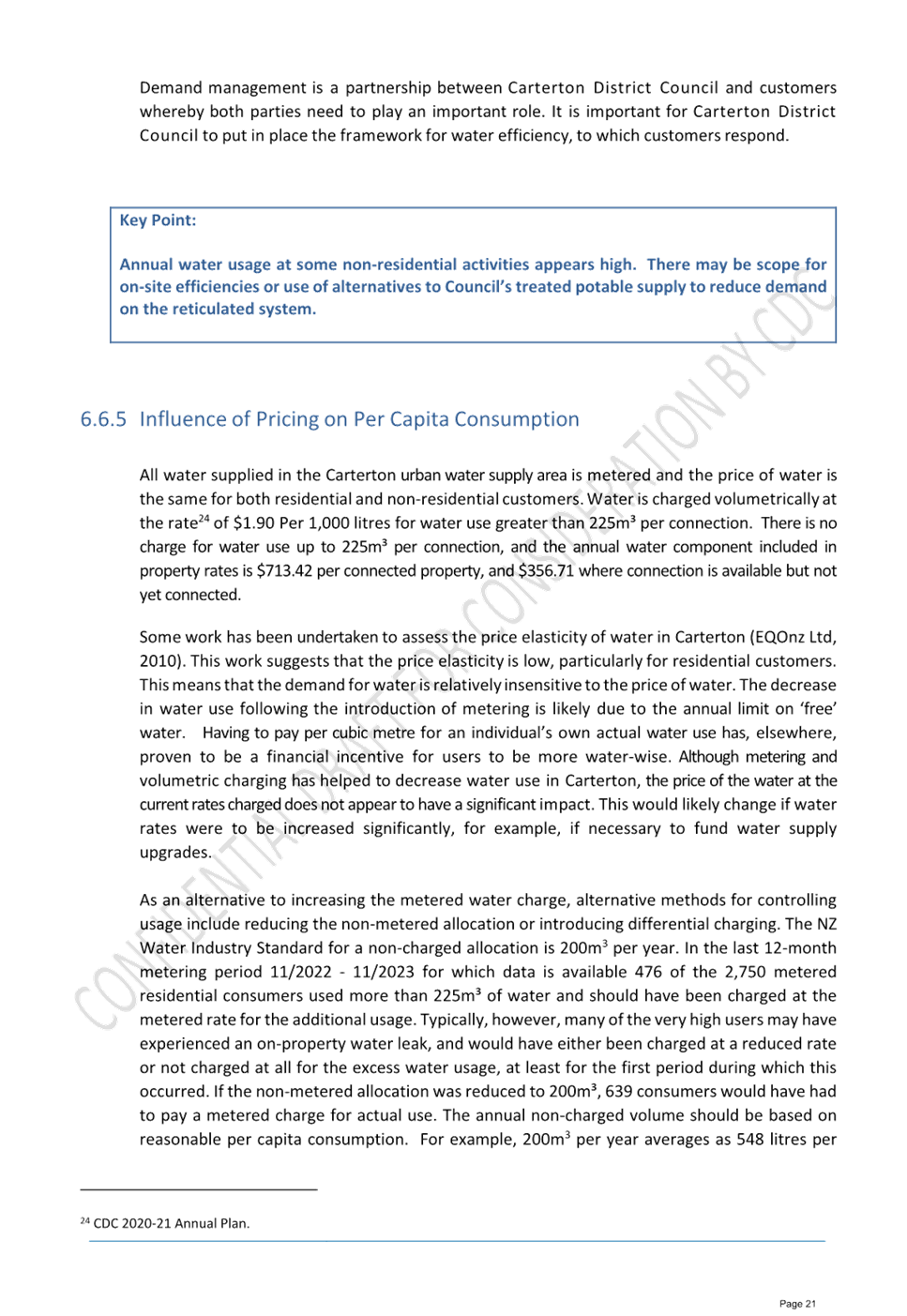


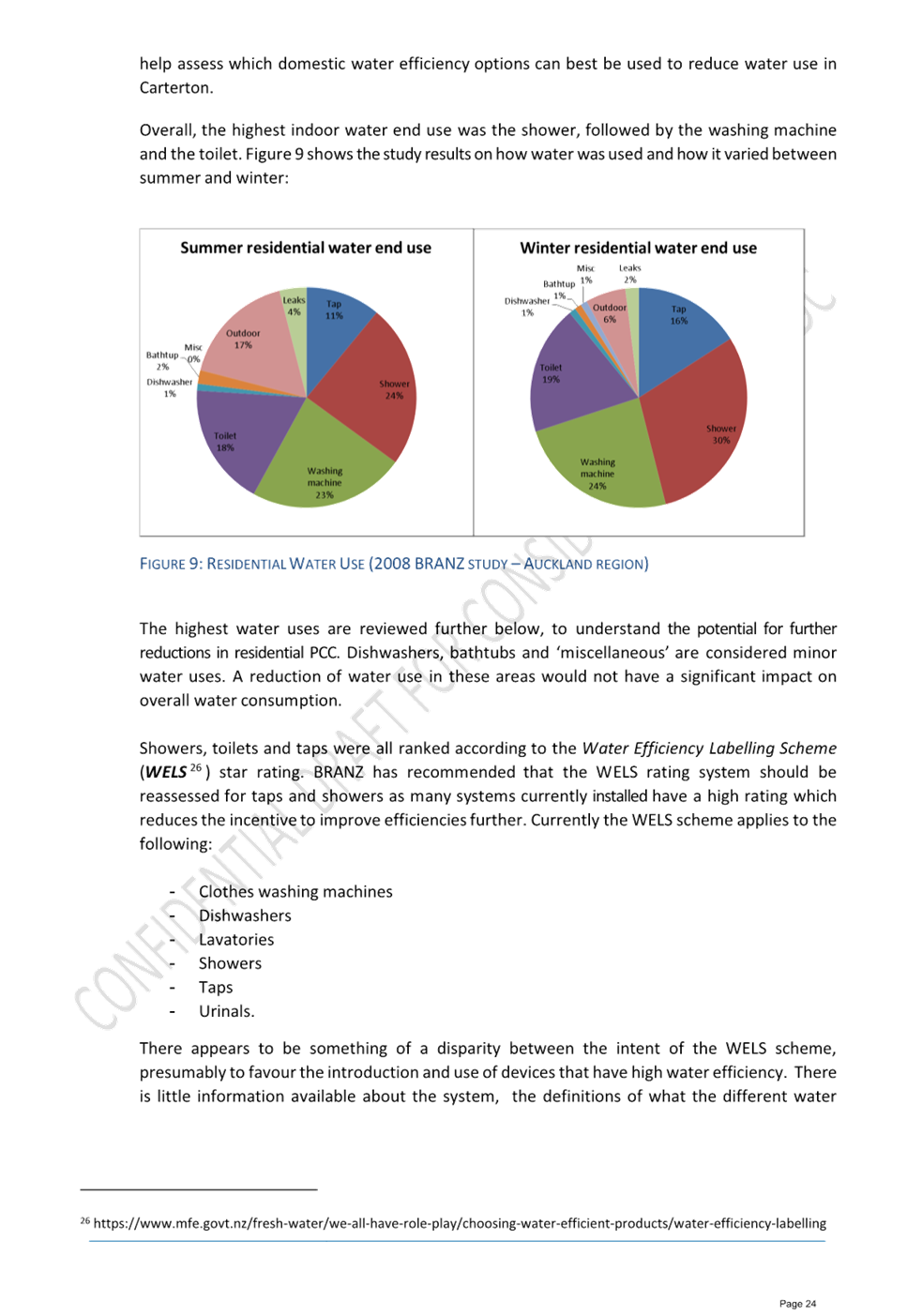
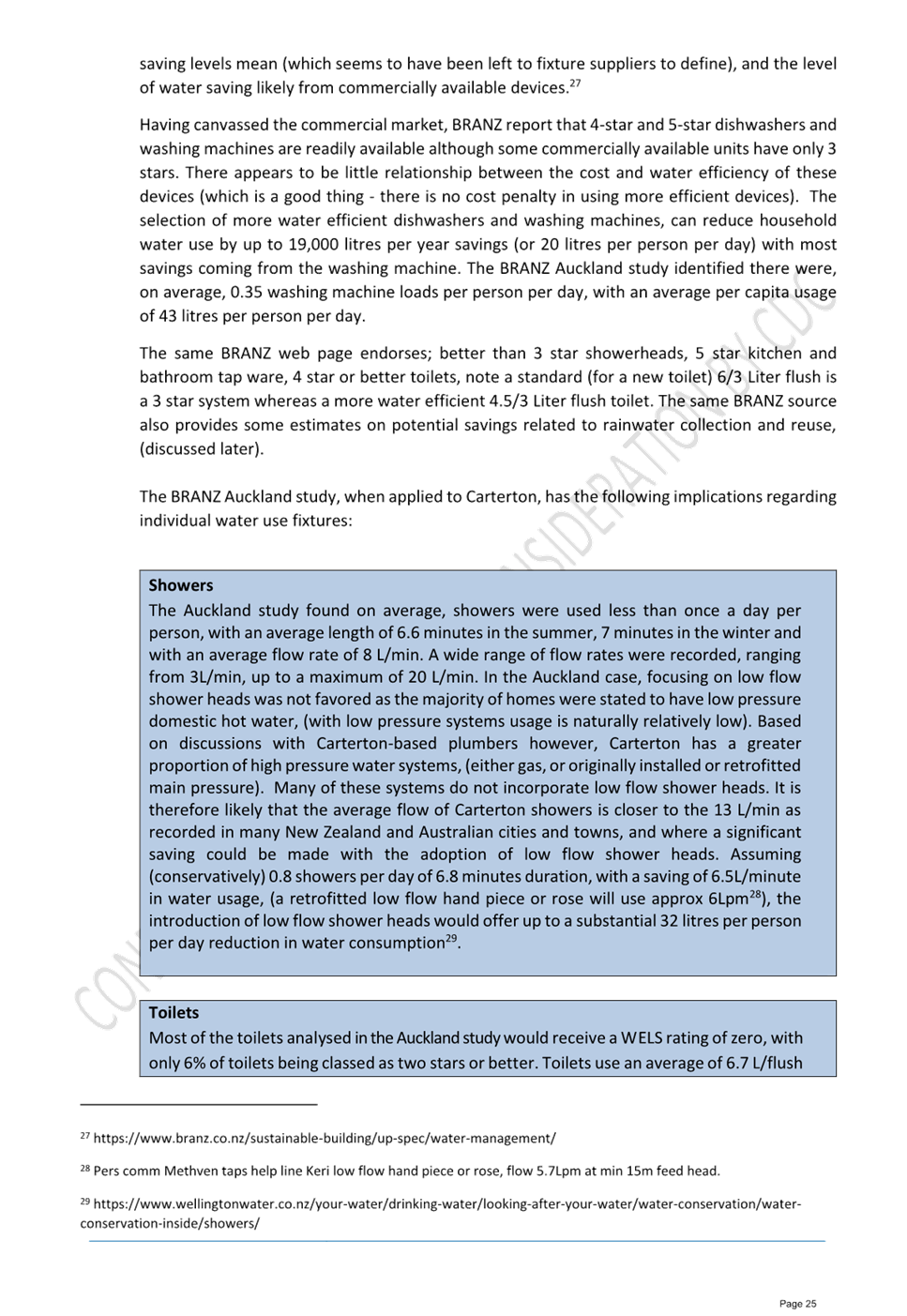
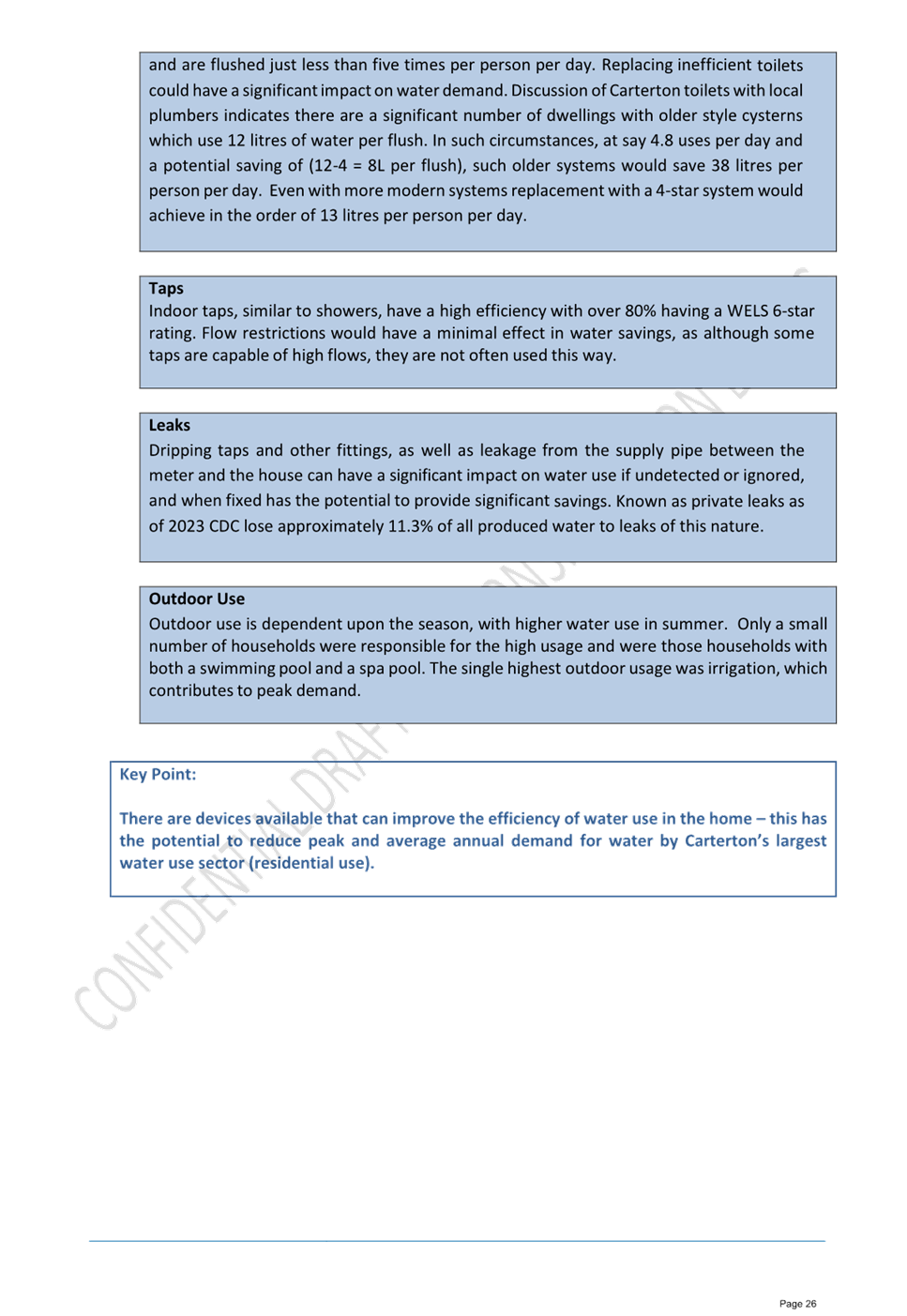


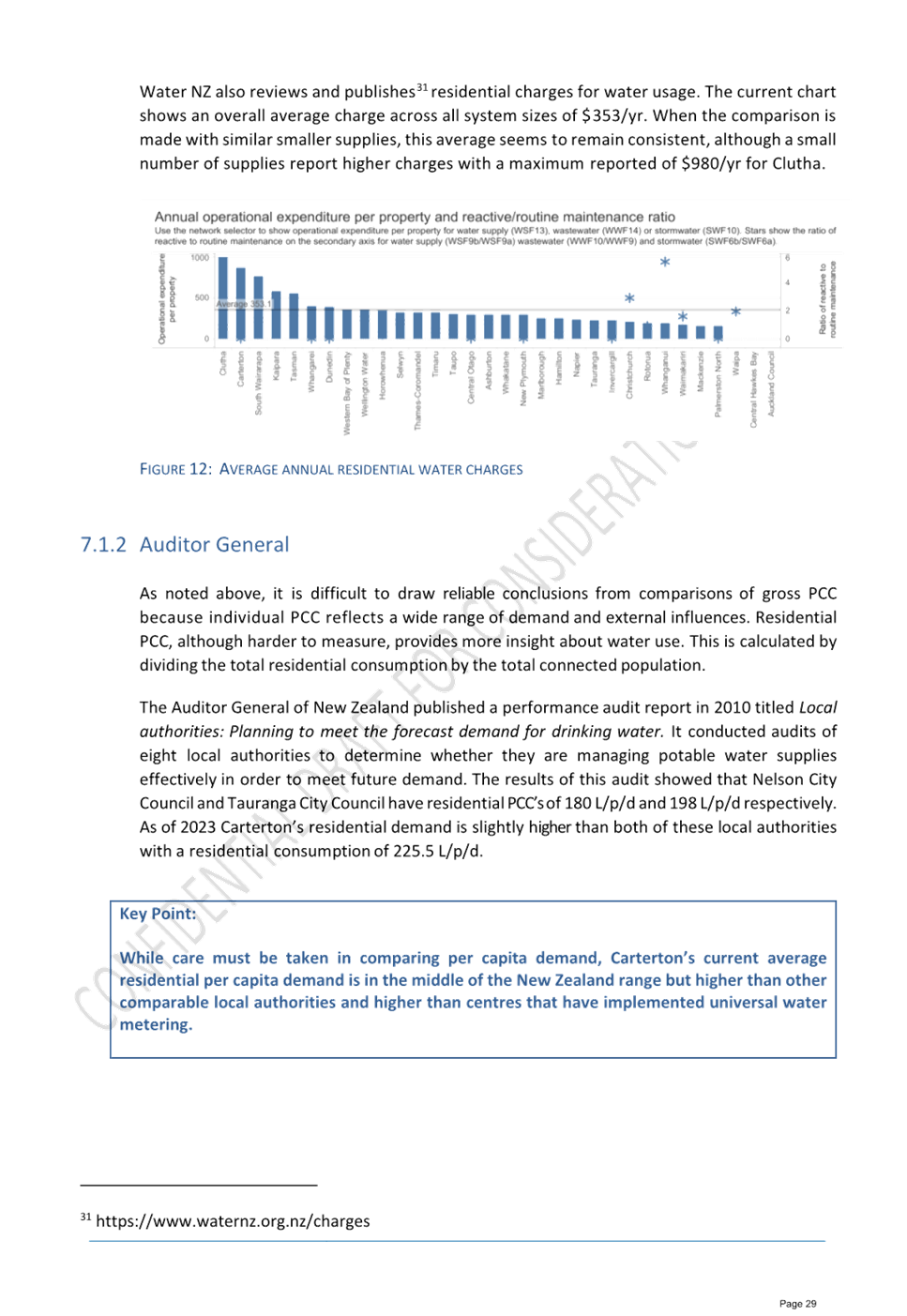
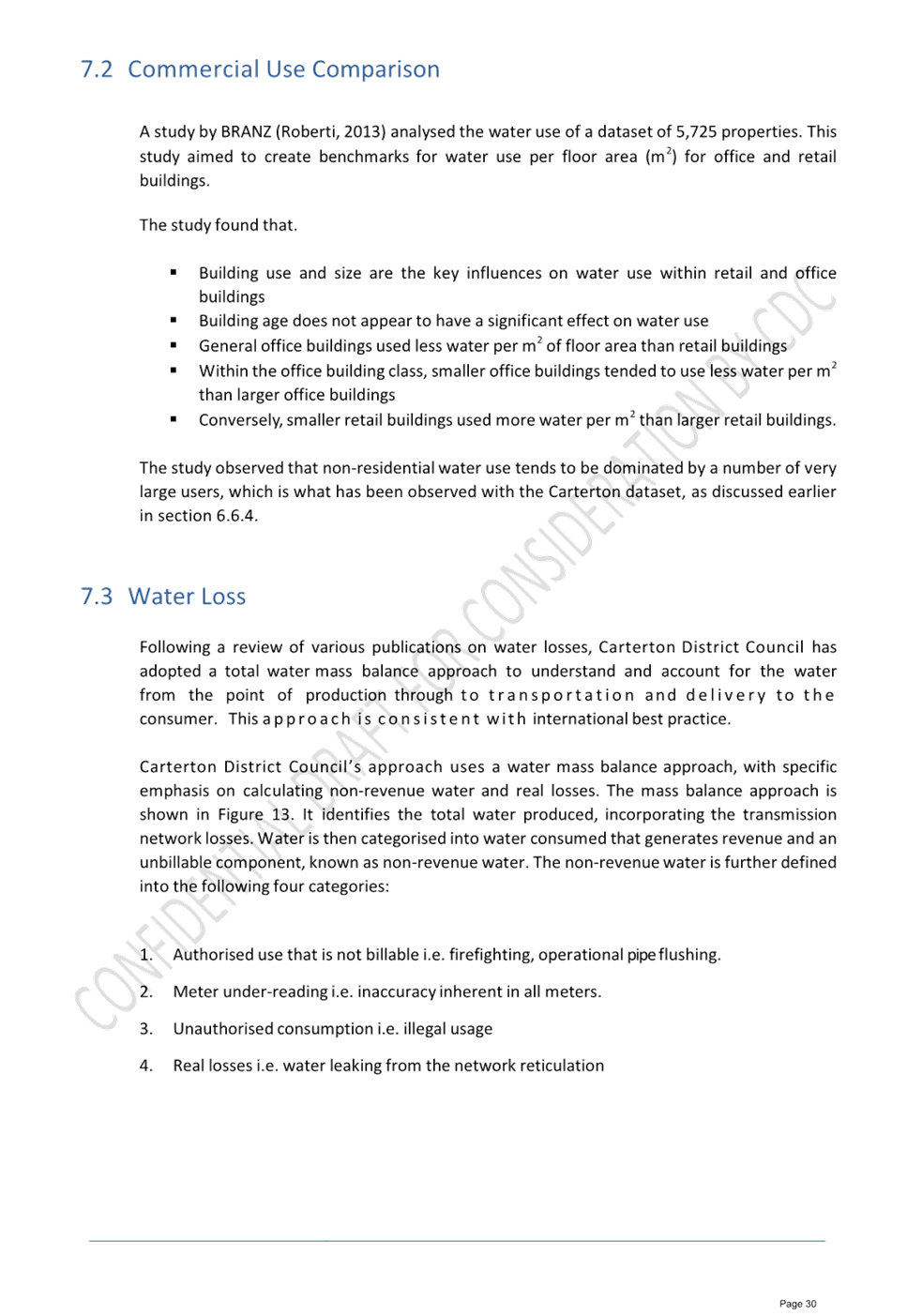
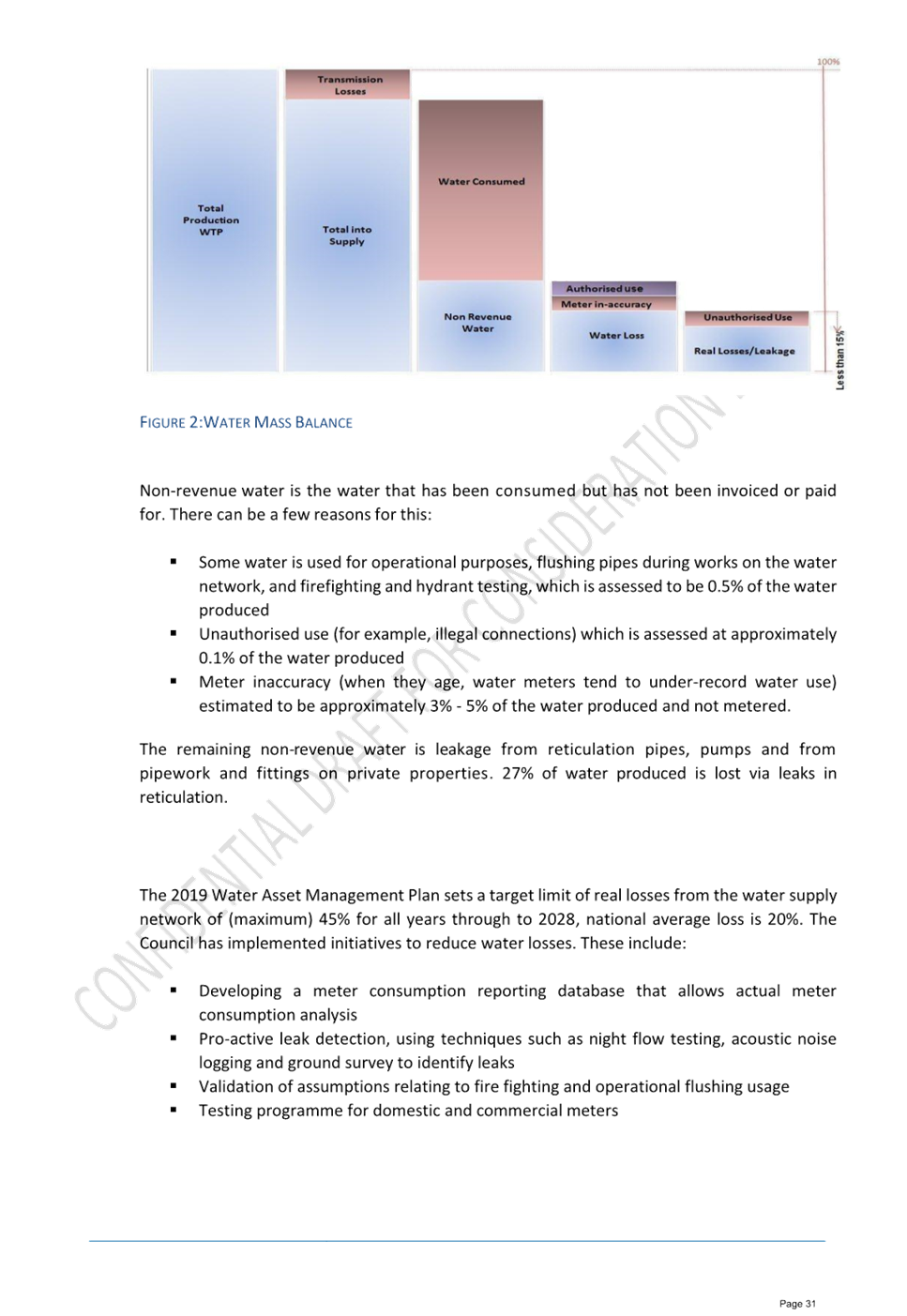
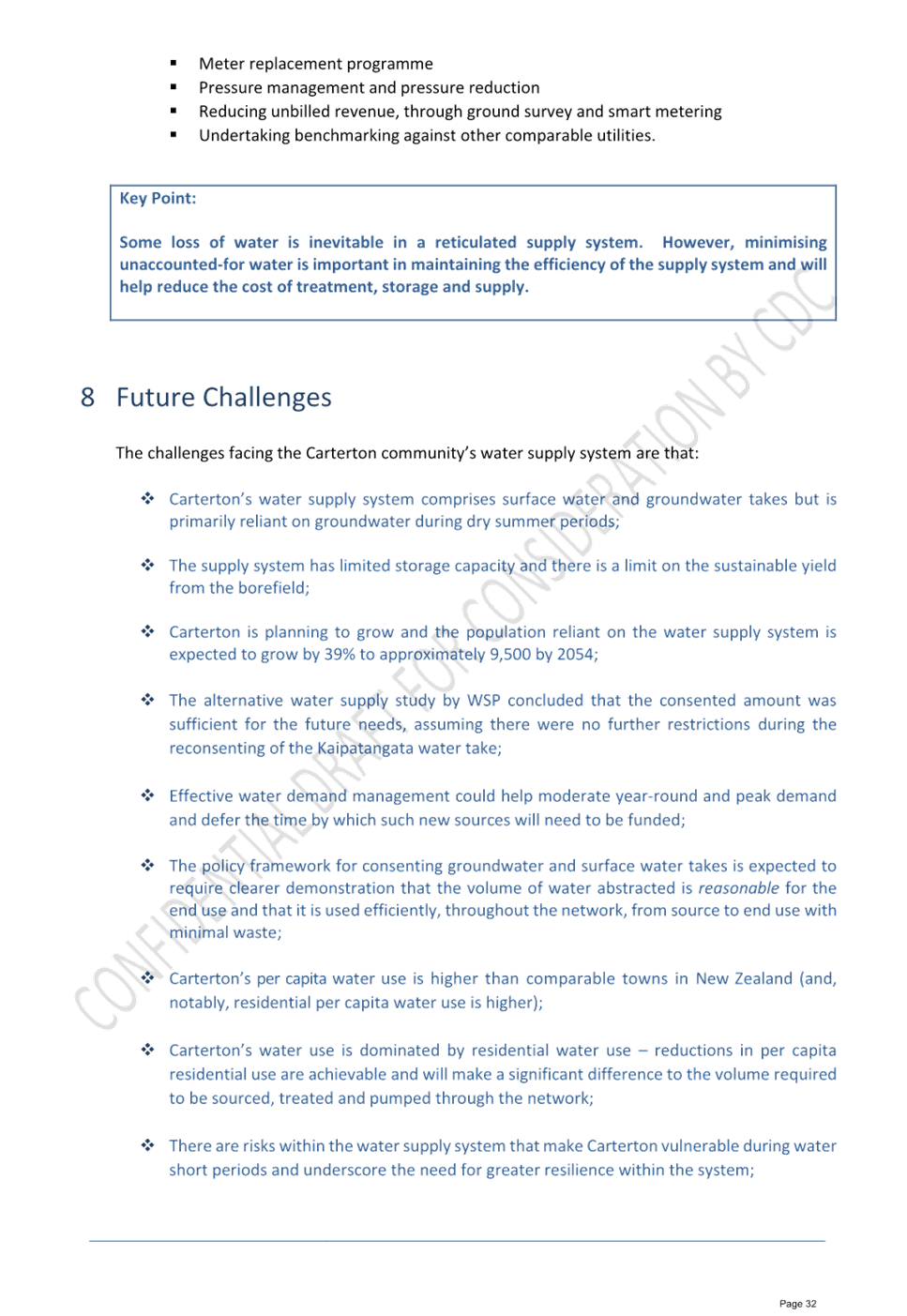

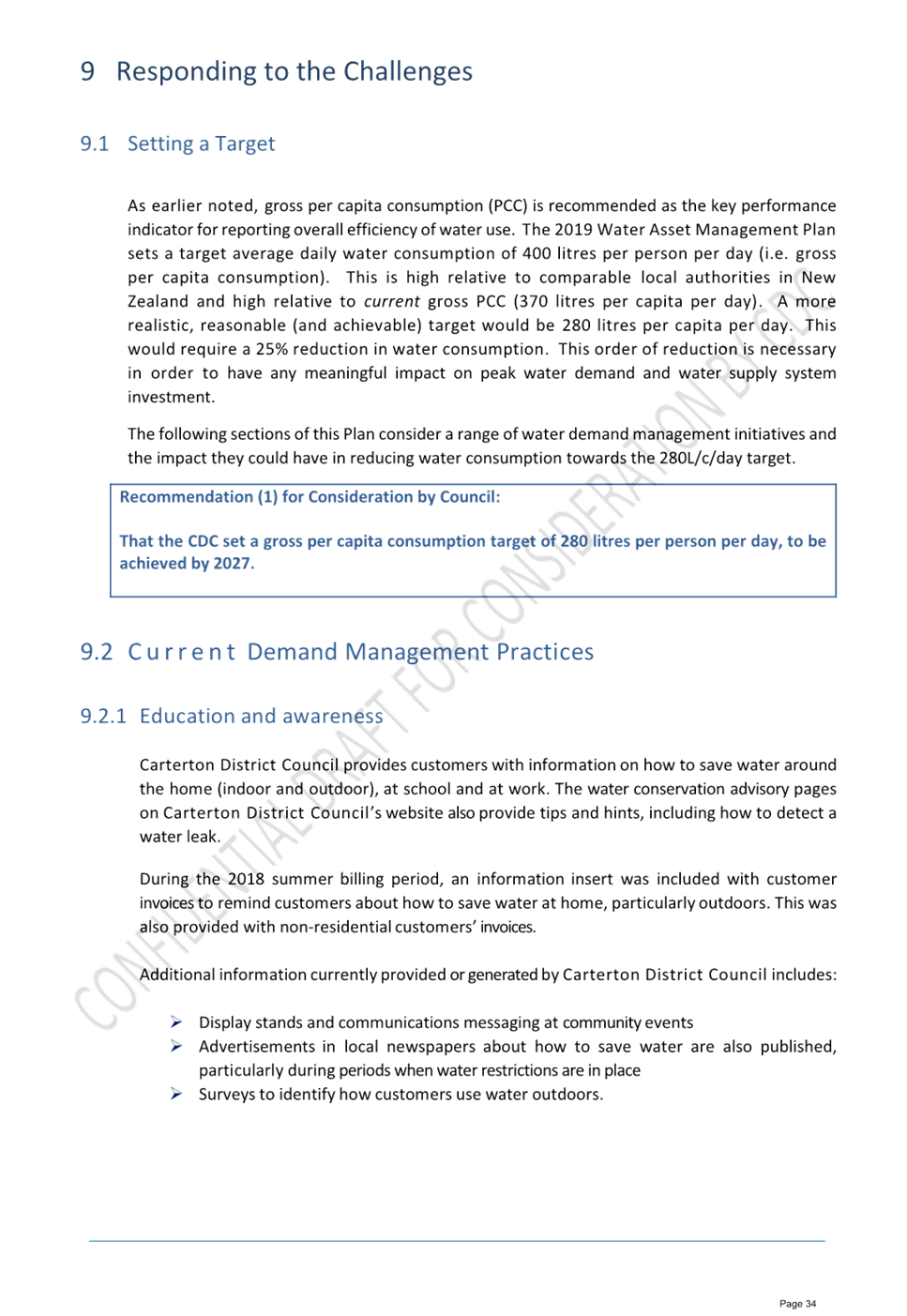

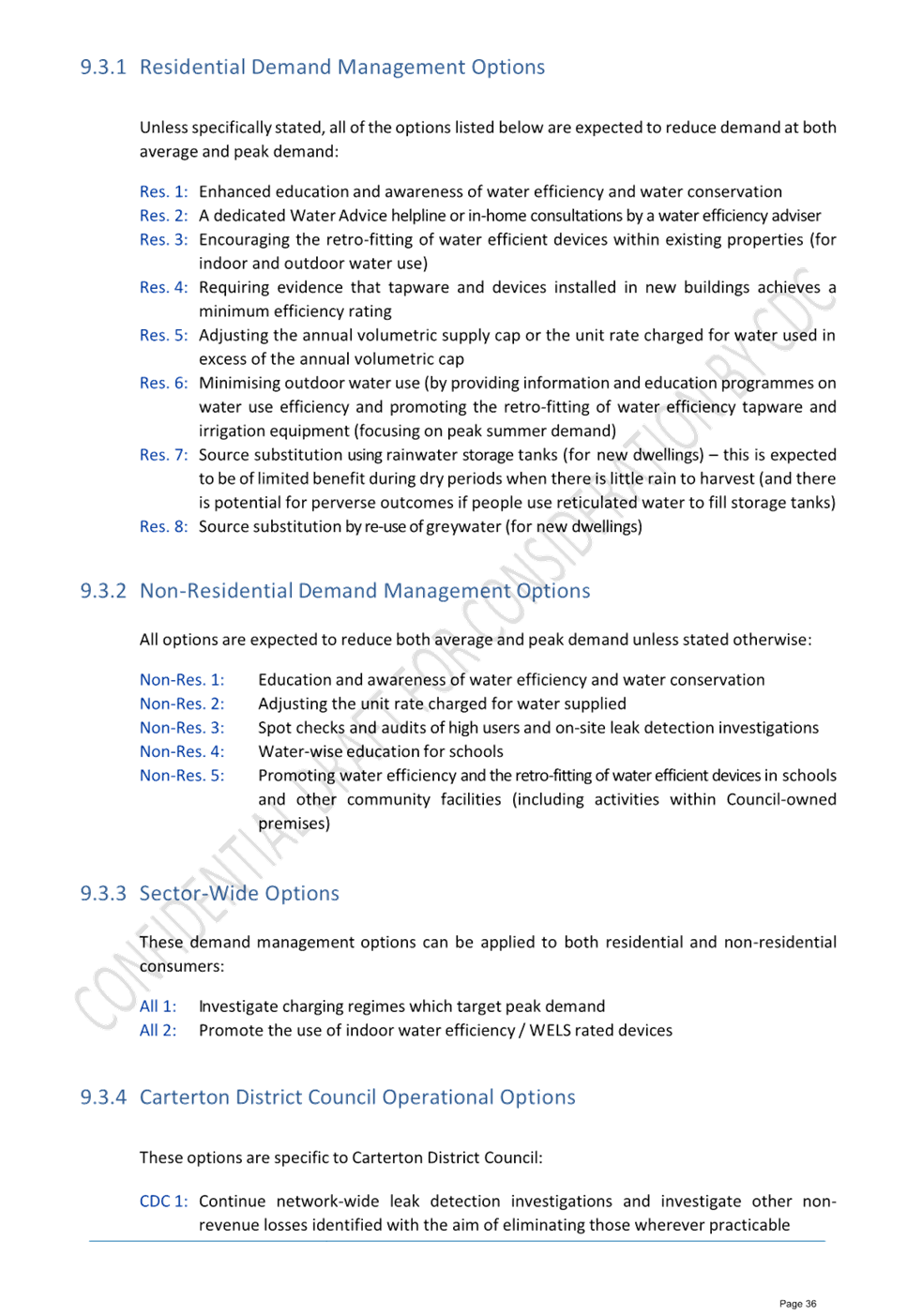
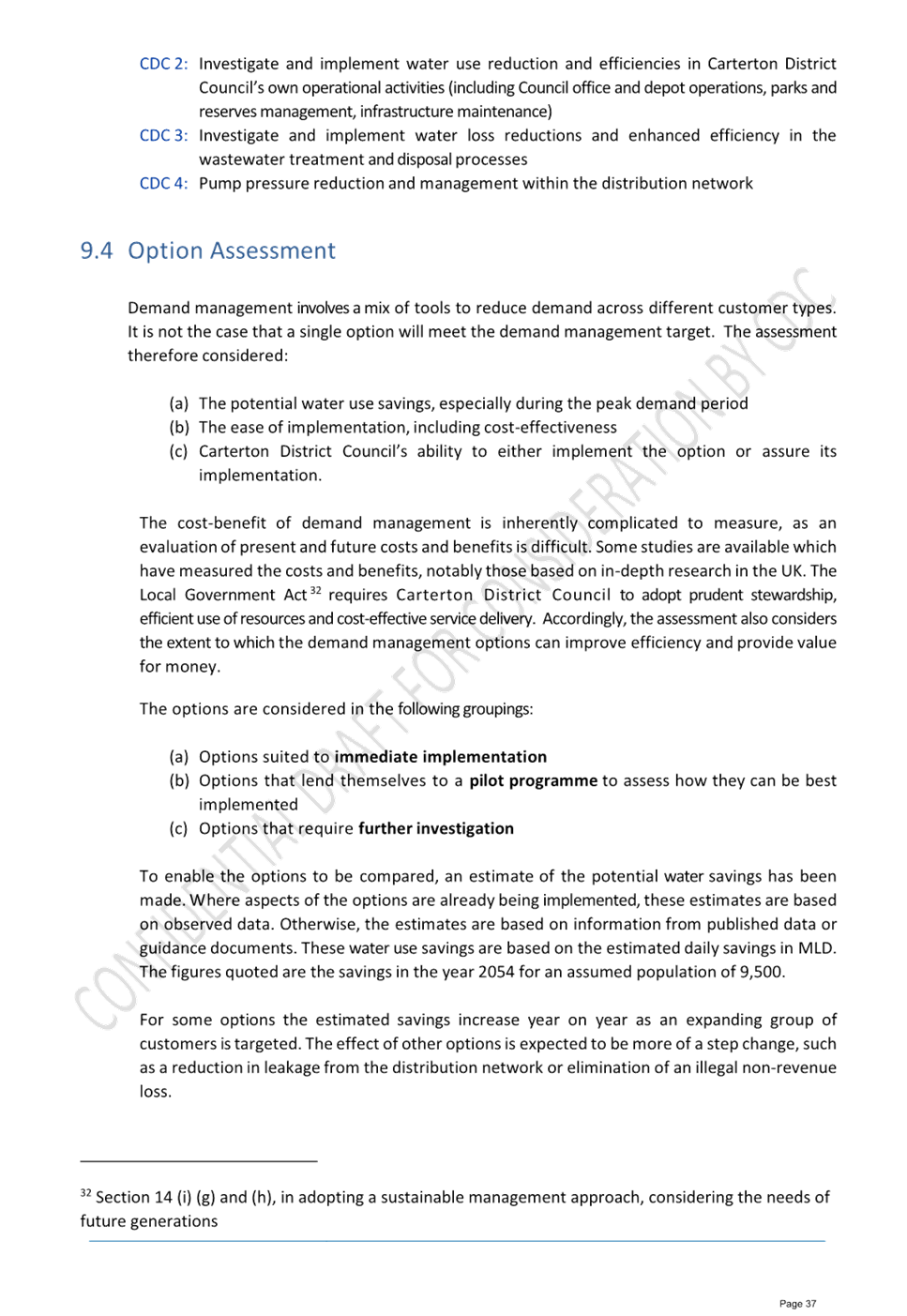
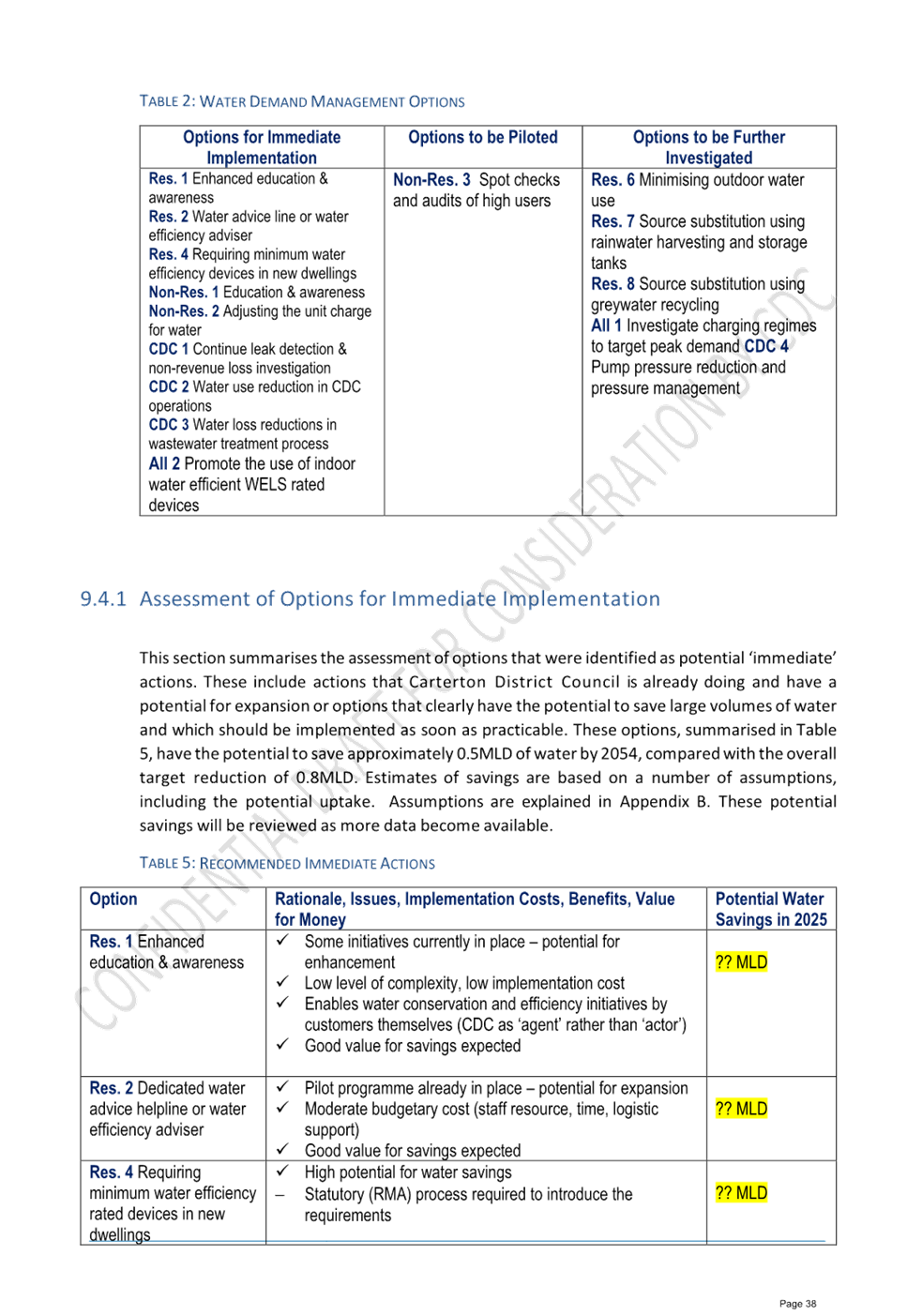
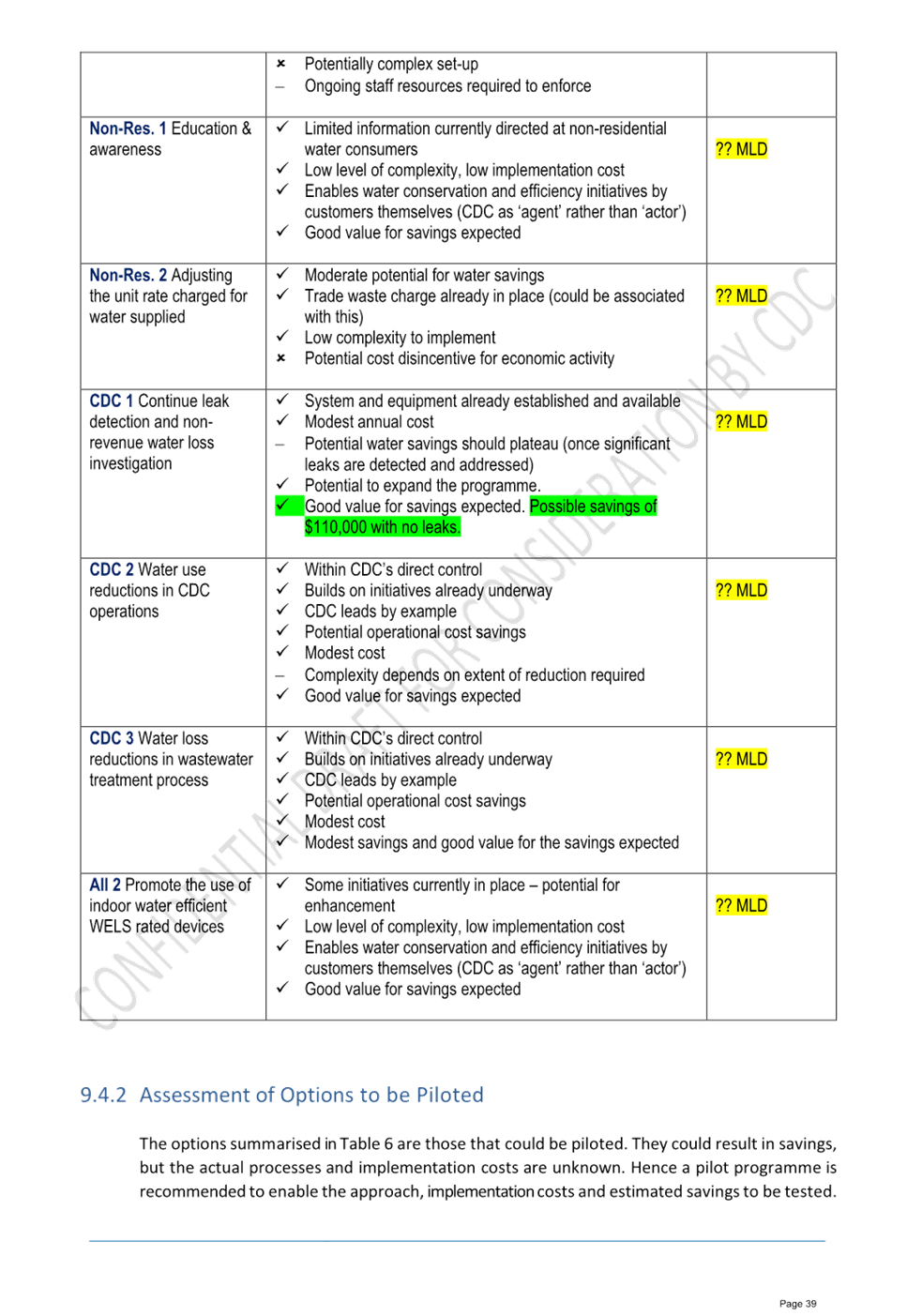
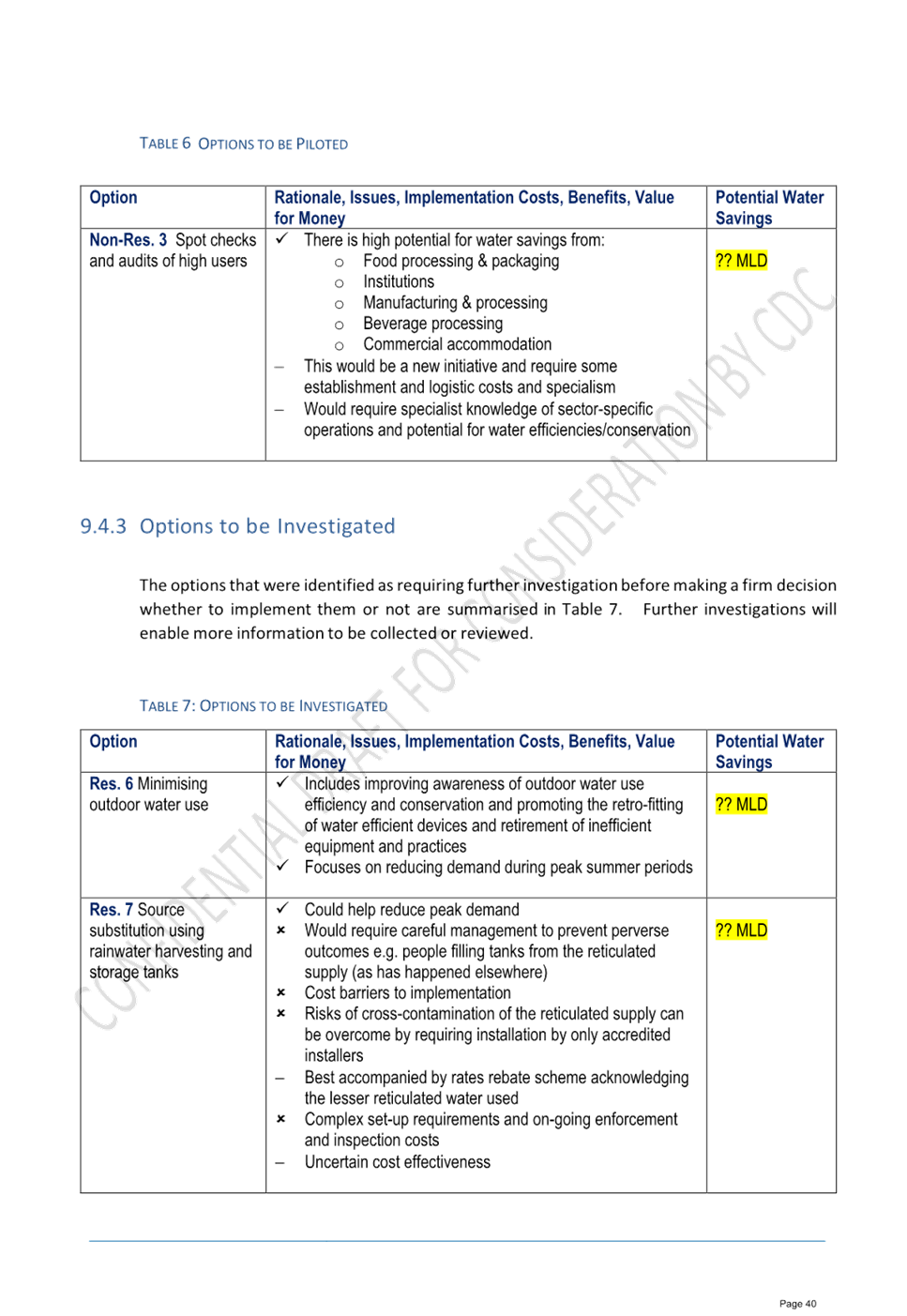
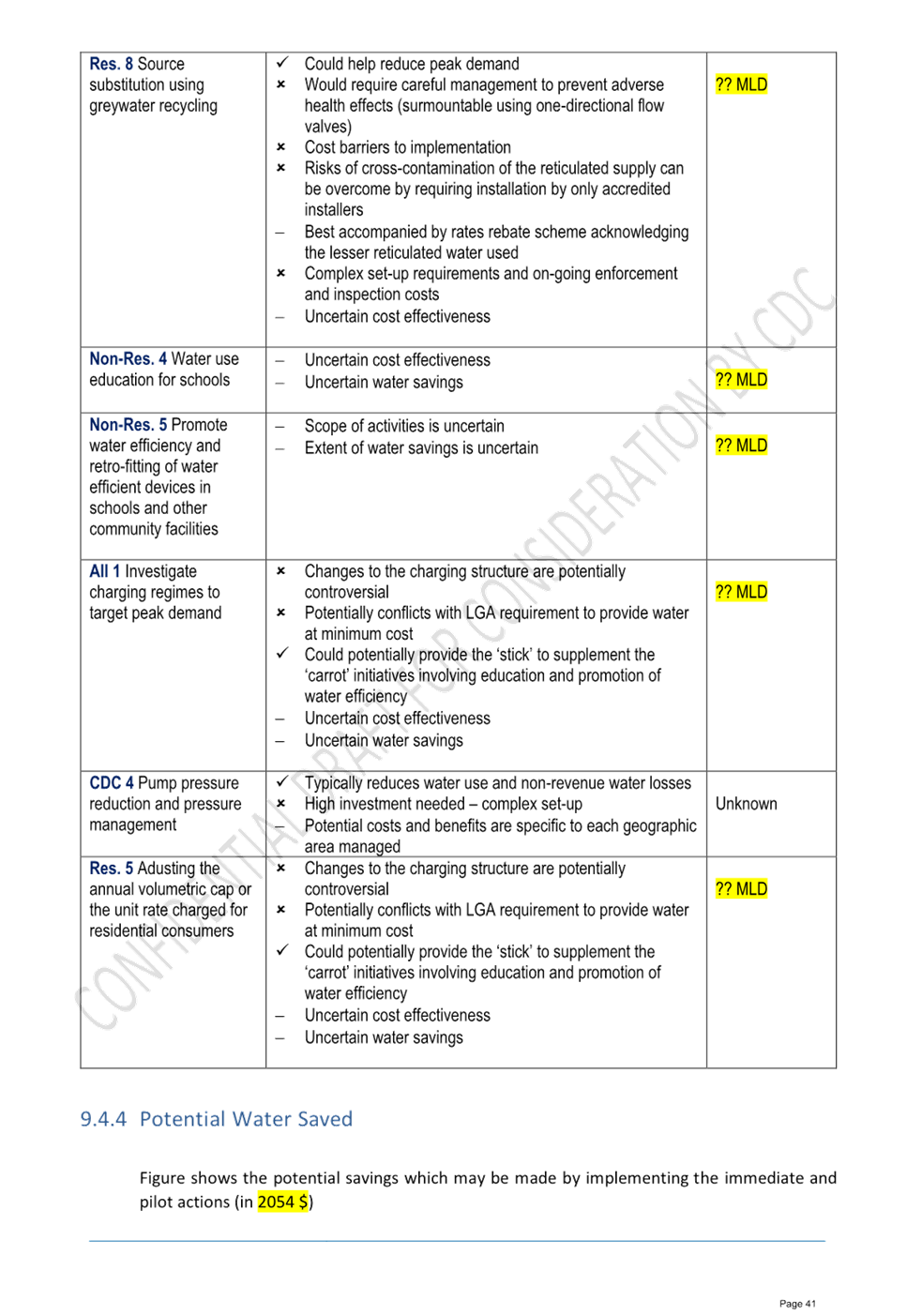
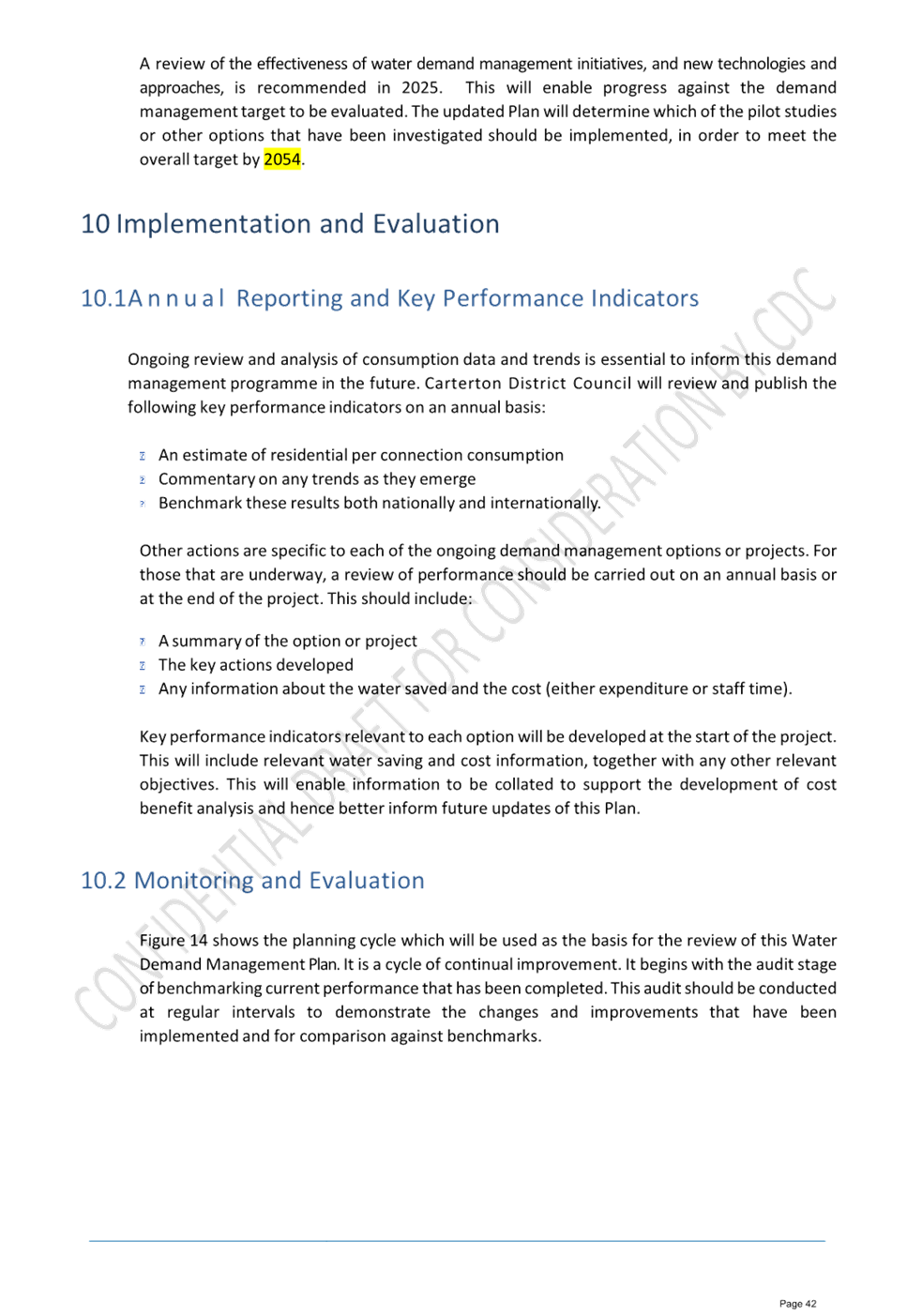
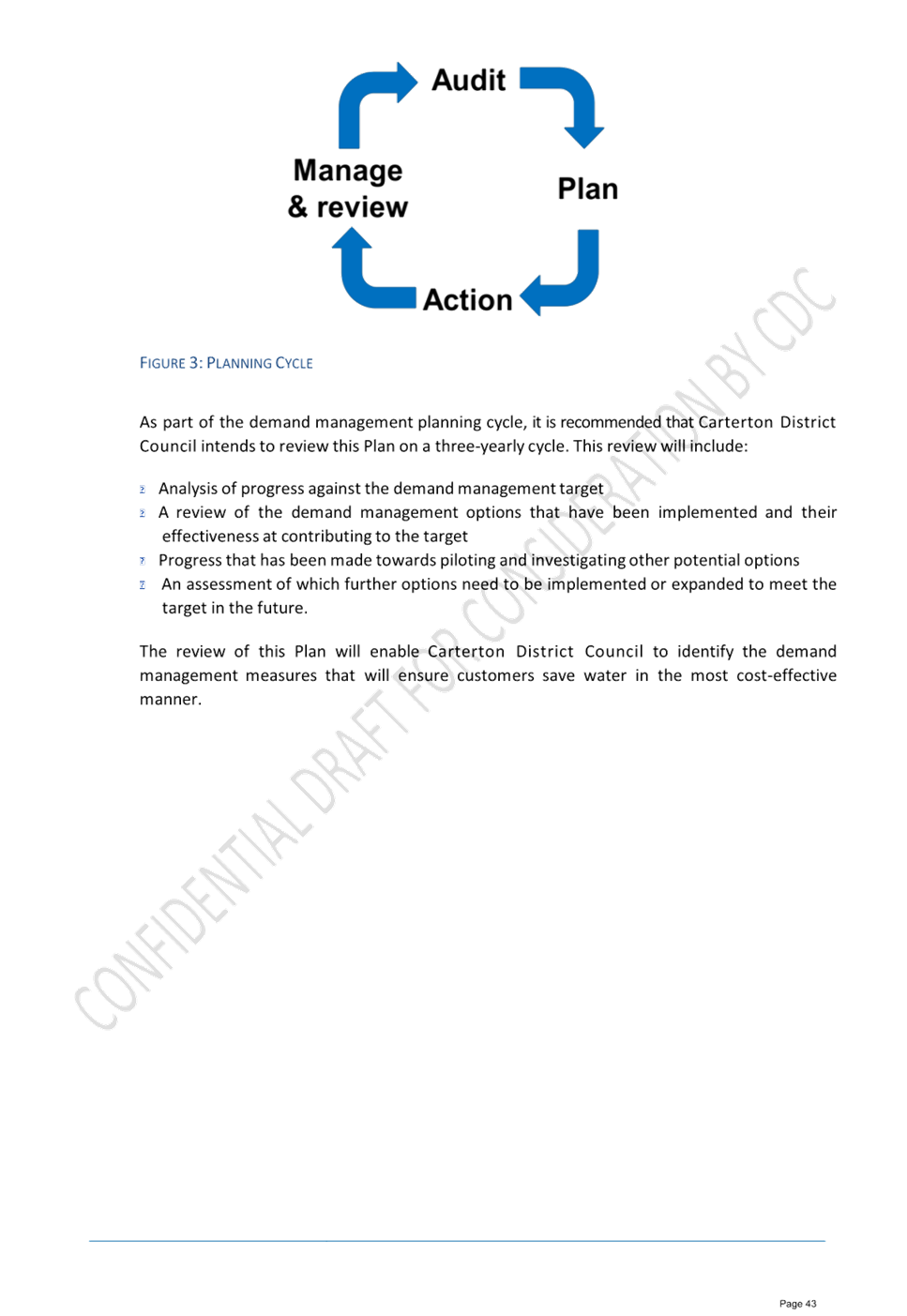
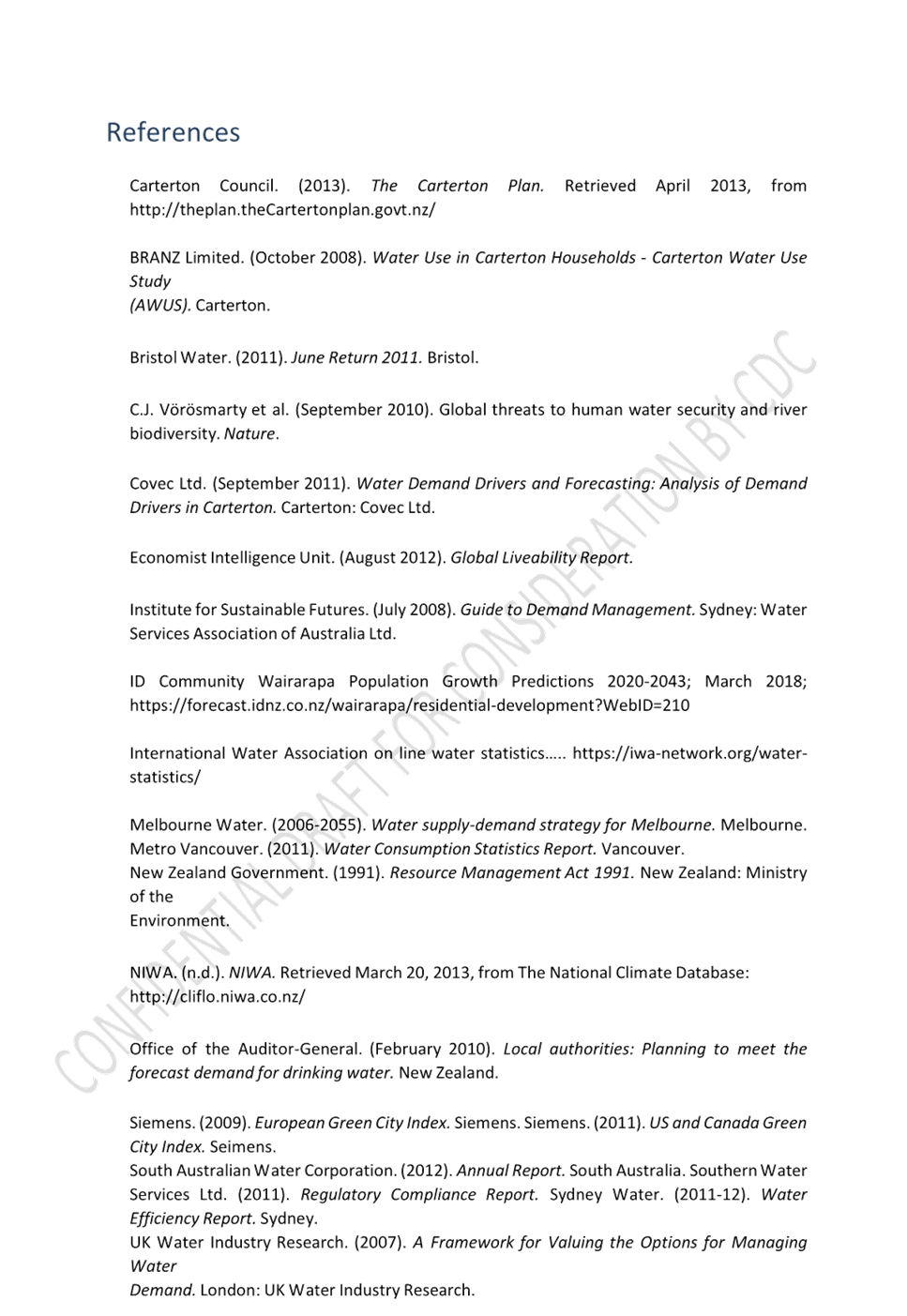

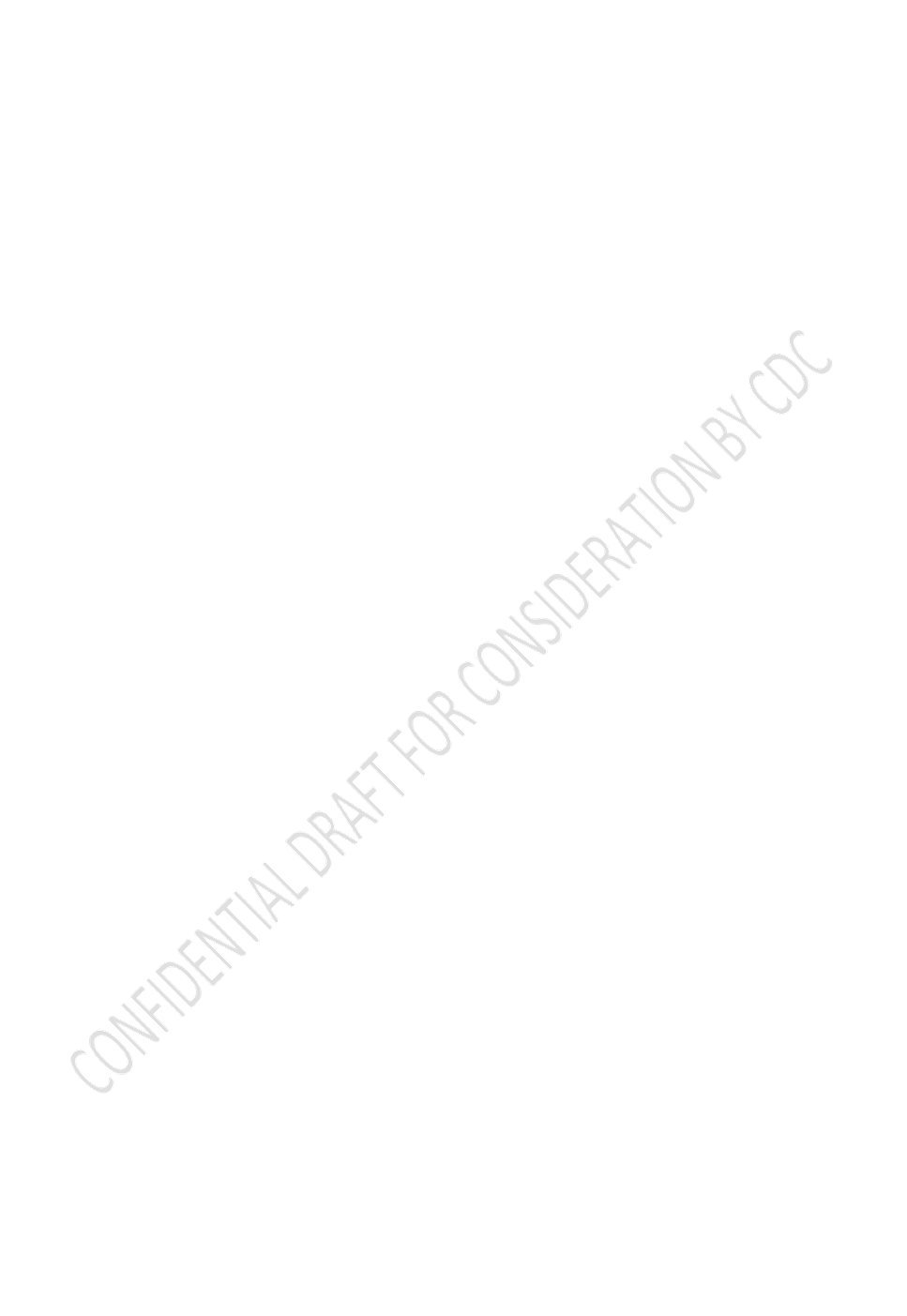
|
Policy
and Projects Committee meeting Agenda
|
28
February 2024
|

6.3 Major
Projects update
1. Purpose
To update the
Committee on the progress of major projects.
2. Significance
The
matters for decision in this report are not considered to be of significance
under the Significance and Engagement Policy.
3. Background
The
Infrastructure Services Team delivers multiple projects as part of the delivery
of the Long-Term Plan.
4. Discussion
4.1 Wastewater
Treatment Plant Reservoirs
We
are pleased to report that all construction defects have been completed and the
reservoirs are now fully operational. The adjustments to the concrete blocks at
the Reservoir outlets were completed by Ordish and Stevens just before
Christmas 2023.
It
was therefore with great satisfaction that CDC finally received the Code of
Compliance Certificate for the construction of the reservoirs on 24 January
2024.
The
installation of the last 4 buoys in Reservoir 1 was outstanding due to
extraordinary delays in delivery from an overseas supplier. This has now
been resolved and the buoys were installed towards the end of January.
The reservoirs are now fully operational.
4.2 High
Street North Rider main construction
Work
on the High Street North Rider main and the lateral connections were completed
on 13 February 2024. This project will have a significant (positive) impact on
CDC’s 3 waters operation budget. The benefits of this project are as
follows:
· No laterals that cross the live lane – meaning that there will
be less load and vibration on the lateral and main connection, which in turn
will result in an extended asset life.
· The laterals that are being removed are past their expected life.
· The pavement can be renewed without the restriction on shallow
laterals. Lateral depths range from 250mm to 300mm, meaning that there is not
much room for building the required pavement.
· The pavement will not have to be dug out for new laterals or
maintenance.
· Future maintenance will be outside of the live lane resulting in a
significant saving in temporary traffic management.

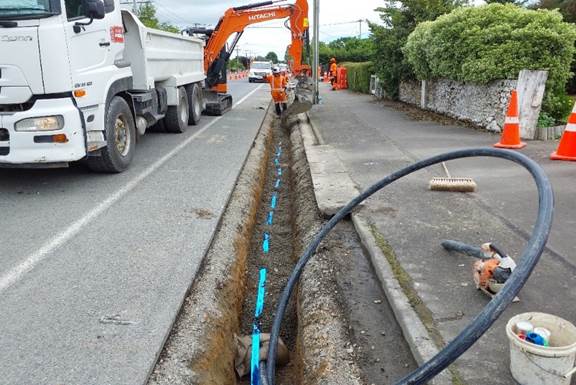
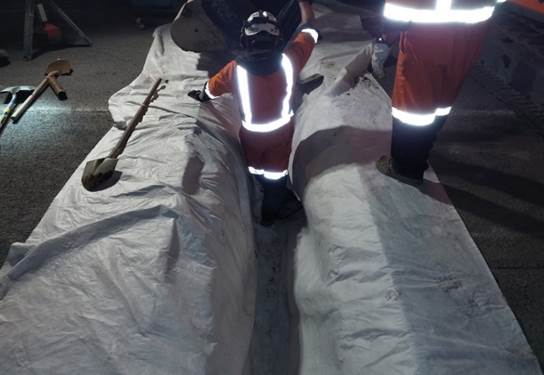
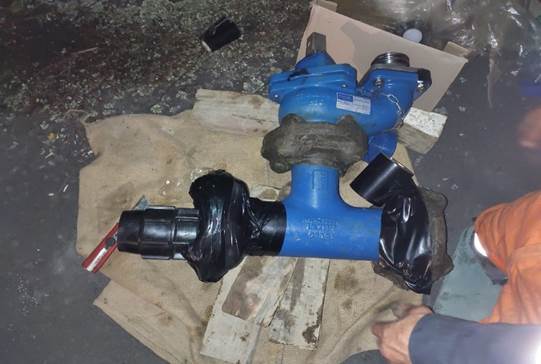
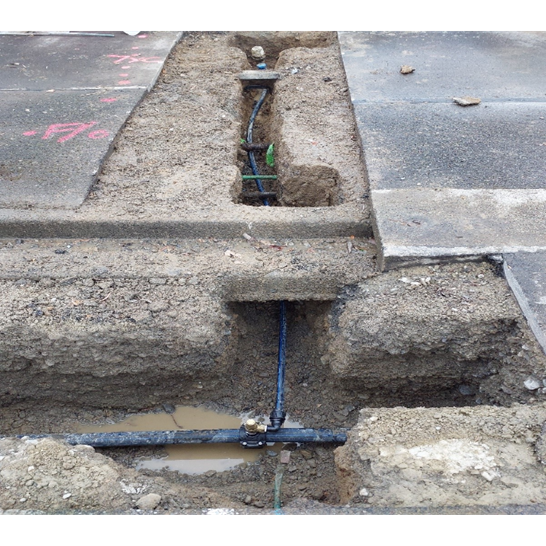
The
work was delivered within the approved annual plan budget.
Items
that have a significant financial impact were:
· Underground services – There were 6 utility services directly
in the area of our trench, meaning that hydro-vacuuming was required to
excavate the trenches. This was more expensive than traditional trenching, but
the safest way to dig and prevent damage to telephone, power, and fibre cables.
·
Temporary Traffic Management – TTM makes
up roughly 40% of the cost estimate and affects by every activity on
site. Although TM has an effect on costs it is also an area of
opportunity to potentially have a saving if the time on site can be reduced.
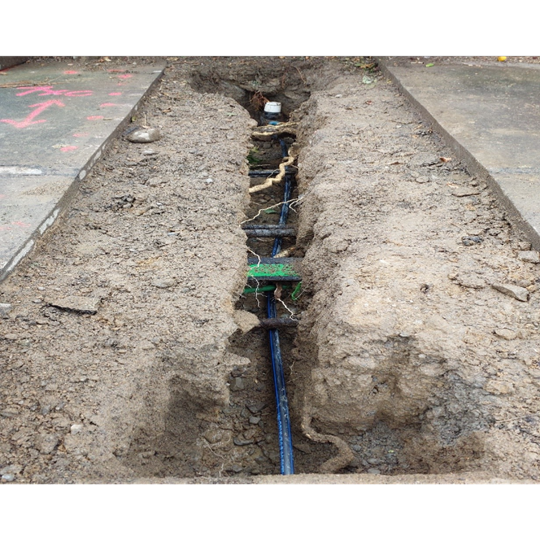
Underground services visible in footpath
4.3 Sewer
Network Renewals
After
considering various options to renew the High Street North Sewer Main it was
decided to defer the renewal of this section due to the estimated costs. The
estimated cost for this section exceeded the current and anticipated next
financial year’s budget combined.
For
the next LTP cycle we will focus our attention to priority 1 sites that are not
on state highway. This will result in getting more meters of critical pipe
network renewed due the significant cost difference in temporary traffic
management cost.
Subsequently,
he next sewer renewal site is on Lincoln Road between Belvedere Road and
Victoria Street. We aim to start construction within the next 6 weeks.
4.4 Brooklyn
Street Water Main Renewal Design
Design
for the replacement of the water main on Brooklyn Street, between High Street
South and Lincoln Road has been started. This will be the next water
reticulation renewal project after High Street North. The route of this pipe
replacement will require the pipe to be laid under the railway track. A
steel sleeve will be drilled under the tracks after which the pipe will be
installed through the sleeve.
4.5 Dalefield
Road Pump Station
Staff
are pleased with the way in which this project was delivered. The project was
delivered on time and within budget whilst delivering on the outcomes that we
aimed to achieve. The project team consisted of Max Tarr Infrastructure
Engineers ltd., Egis NZ and CDC officers. Key drivers to the successful outcome
can be attributed to:
a. Detailed project
scope definition and design. The infrastructure team worked collaboratively
between Operations, Asset Development and Projects to ensure that the final
product would be operationally sound.
b. Procurement process
– A thorough procurement process was followed using a Price Quality
Evaluation method. This allowed the evaluation team to consider the tenderers
relevant experience, track record and broader outcomes.
c. Contract management –
The team delivered the project in line with NZS 3910 with all parties staying
within their defined roles.
d. Sufficient time and
budget – The time allowed for the delivery of the entire project was
sufficient while having a very firm targeted completion date. The fact that the
budget was approved based on the preferred design and tender outcomes, meant
that quality was not compromised.
We
endeavour to continue to follow this approach in future to ensure the best
outcomes for our community.
4.6 Climate
change mitigation – Solar Project
The
primary focus of this project is to reduce Carterton’s annual operational
cost through the investment of better of funding. The climate change benefits
are a secondary outcome.
As
part of our procurement process, we received two compliant tender submissions
on 14 November. The tender evaluation team has identified Hoskins Energy
Systems from Carterton as the preferred tenderer. Hoskins’ proposed
methodology will require a resource consent as a discretionary activity. We
have engaged Incite – A Wellington resource management consultancy, to
prepare the resource consent application.
4.7 Dalefield Road
Sewer
CDC has been waiting for Downer to return to the site to remedy
surface defects on the trench reinstatement as identified in the post
construction walk over.
This work was done on 12 February 2024.
4.8 Lincoln
Road dual water main
CDC
have similarly been waiting for Downer to return to site to do surface repairs
to the trench areas identified in the post construction walk over.
This
work was done on 13 February 2024.
4.9 Valve
testing
Detection
Services have completed their survey of the Council’s valves on 15 Jan
2024. Their report was submitted 23 Jan 2024 and is currently being
evaluated. It is important to have an updated condition assessment of the
underground valves to enable Council to prioritise repairs and spending as well
as having a clear understanding of the risks associated with possible failure
of these assets.
Failure
of valves can lead to:
· underground water loss
· loss of water to residents
· damage to roads and other infrastructure
· loss of or, no available water for fire-fighting purposes
The results of
this exercise were as follows:
Total amount of valves in
Carterton 348
Total valves exercised
269
= 77%
Unable to
exercise 79
= 23%
Leaking
Valves
31
= 9%
The data shows that while there are a large number
(79) of inoperable valves, whilst 77% of CDC valves are in working condition.
This information will now be used to update asset data and inform forward work
planning.
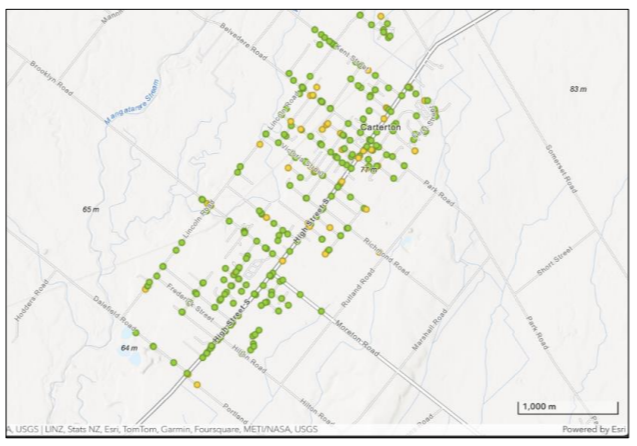
1 Aerial view of CDC valves assessed by Detection
Services
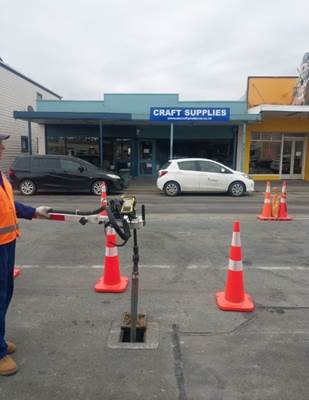
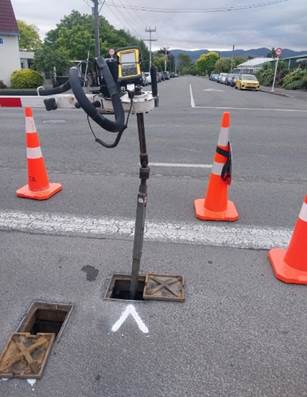
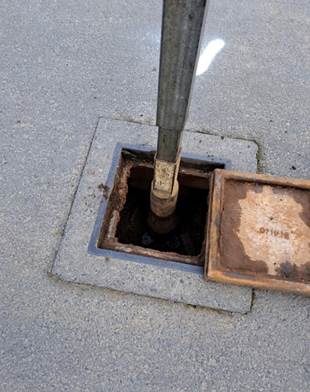
Valve
testing in progress
5. NEXT
STEPS
The
Infrastructure Services Team will continue to deliver on these projects and
ensure the Committee is informed on progress.
6. CONSIDERATIONS
6.1 Climate
change
Climate
change is considered in project planning and development as required.
6.2 Tāngata whenua
This
report is a regular update which is of interest to all members of our
community, including iwi and hapū. However, there are no particular areas
of interest or concern contained within this report that require specific iwi
or hapū input.
6.3 Financial impact
The
financial matters in the report are covered within existing budgets.
6.4 Community Engagement requirements
There
are no community engagement requirements required for this report.
6.5 Risks
Project risks are
being managed and mitigated as and when required.
7. Recommendation
That the Committee:
1. Receives
the report.
File
Number: 384333
Author: Christo
Heyns, Project Manager
Attachments: Nil
|
Policy
and Projects Committee meeting Agenda
|
28
February 2024
|

6.4 Waingawa
Process Water Project
1. Purpose
For the Committee to
be updated on the project progress and consider future of the Waingawa Process
Water Project.
2. Significance
The
matters for decision in this report are not considered to be of significance
under the Significance and Engagement Policy.
3. Background
Following
endorsement by the Policy and Projects Committee, on 13 September 2023
Council approved unplanned expenditure for the Waingawa Process Water Project
(WPWP). The Policy & Projects Committee endorsed the project on the basis
that the project would proceed progressively, achieving specific deliverables
at each milestone.
4. Discussion
As
the project progressed through the milestones more information has become
available which has changed the risk profile of the project deliverables
negatively. An update on the various milestones follows:
4.1 Policy and Project Committee
endorsement - Endorsed 16 August 2023
4.2 Mana Whenua support and formally
endorsed the project – Mana Whenua’s
support for this project will be critical when applying for the GWRC resource
consent for the bore and will be required for the physical works to proceed.
Meetings have been held with both Kahungunu ki Wairarapa and Rangitāne Iwi
representatives. Both were supportive of the concept and will confirm their
individual official position following further deliberation internally.
4.3 Council approval of unplanned
capital expenditure drawn from Reserves, with loans required – Approved 13 September 2023
4.4 Masterton District Council (MDC)
$250,000 contribution – On 13 September 2023
MDC agreed to provide funding to the project of up to $250,000 on terms that
do not disadvantage Masterton ratepayers. Following the adoption of
this resolution, MDC officers proposed to treat the funding as a loan to CDC,
which was not in line with the request for capital funding. The way MDC
fund this request is not a matter for CDC. Management continues to
progress on the basis funding will be in line with our request – i.e.
capital funds, and not a loan.
4.5 Kānoa approved $1,750,000 of
grant funding – Approved.
4.6 JNL agreed to a 10-year
supply agreement – To date, JNL has not committed to
a long-term take agreement. JNL has however indicated that they were not in
agreement with the original proposed take of 65,000 mᵌ
and were thinking more towards 35/45,000 mᵌ. This was noted as one of the more significant risks
identified.
4.7 Master plan design and
construction estimate to be completed – The
design and estimate has been completed – The updated estimate is noted
under Item 7.3 Financial Impact.
4.8 Concrete Tank condition assessment – The condition assessment that was completed recommended
further Geotech and concrete reinforcement assessments which will have an
impact on the cost estimate. The updated estimate is noted under Item 7.3
Financial Impact.
4.9 Detailed design for procurement
– not started.
4.10 Resource consent for the bore supply – not started.
4.11
Risk Assessment
Further to the milestones discussed above, the project team is
actively managing the associated risks.
An updated risk assessment follows:
a) Co-funding from
Kānoa is fixed and therefore CDC will own the risk of project cost
overruns or variations. - This risk has been validated after Kānoa
confirmed that there will not be support for the increased cost estimate.
b) The final design exceeds the
initial project estimate. - This has occurred not only due to design but
also further requirements like the proposed Geotech and concrete testing.
c) Tendered prices exceed
the initial/design estimate.
d) Affordable Waters Reform
– CDC will lose our in-house Three Waters Operations team currently used
for all for waters maintenance and operations activities. – This is
unlikely to occur now.
e) GWRC Resource Consent
for the bore water take may take longer than anticipated, cost more than
expected, or be widely notified. – highly likely to be required based
on the bore assessment.
f) Due to proximity of the
wetlands the final bore location may be a considerable distance from the tank.
- highly likely to be required based on bore assessment.
g) Bore supply could have
“take” restrictions during summer. Unlikely to be clarified
until we have submitted a resource consent to GWRC.
h) Water tank proximity to the
earthquake fault line. No further update.
i) Bore water
quality is still unknown and may require treatment / filtering if not suitable
for non-potable purposes. No further update.
j) The proposed bore
site is in a known contaminated site, where bulk storage of hydrocarbons,
mineral acids, and the treatment of hides historically took place. No
further update.
k) It is not known whether
there is sufficient power supply to the site for the pump station. No
further update.
l) JNL uses
roughly 70% of current Waingawa potable water supply from MDC. A significant
reduction in demand from JNL (e.g. a rainwater roof capture system, a reverse
osmosis plant) will have a significant impact on CDC’s ability to recover
the cost of this investment - Refer to Item 4.6.
m) Success of establishing a bore
– based on the bore assessment there are numerous risks associated with
the establishment of a bore in this area that could compromise our ability to
take water. Geotech reports suggest establishing a borehole is likely to
result in a further cost escalation.
4.12
Cost Estimate and Funding
Due
to various considerations the estimated cost to complete has increased to
$2,767,679. It is noted that the detailed design and tender processes
will further refine and confirm final cost estimates.
Based
on the estimates the project is proposed to be funded as follows -
1. $1,750,000 - Kānoa
2. $ 102,000 -
CDC (Waingawa Reserves funded)
3. $ 915,679 -
CDC Loan – funded through Process Water Charges
4.13
Cost Benefit analysis
Whole
life cost over 50 years (excluding depreciation,
inflation, or growth).
1. Establishment
cost $2,767,679
2. Operational
cost - $26,640/annum $1,332,000
3. Interest
on Loan - $530,234 (10 yr x $53k/annum) - $398K $332,004
Whole
life cost $4,431,683
Revenue
(assumed $1.00 / CUM) $ 57,500p.a. x 50 $2,875,000
Benefit
/ burden
($1,556,683)
5. Conclusion
Three
critical elements of this project have changed, and all of them have adverse
impacts for CDC.
Firstly
the cost to construct the infrastructure have increased from $2.5m to
$2.77m. Kanona is not prepared to support any costs increases, meaning it
is likely all of the increase will fall on Carterton ratepayers increasing our
funding demand from $500,000 to $767,679.
Secondly
the anticipated revenue earned from JNL has been scaled back due to their
revised raw water demand forecasts. Additional risks remain with
JNL installing rainwater collection and reverse osmosis systems on site, which
will further reduce demand for process water.
The
revenue assumptions over the 50-year project life does include additional
customers connecting to the Process Water reticulated network. Combined
with JNL, we have assumed demand for Process Water will average 57,500cum p.a.
compared to 60,000cum at the outset of the project.
Thirdly
the geotechnical report has indicated risks with drilling a bore on site due to
the earthquake fault line and hinted at further cost escalation with moving the
bore to an alternative site.
Due
to these changes and some new risks being identified, it is now unlikely that
the project outcomes can be successfully delivered without significant increase
in the project budget. The increase in investment required, and reduced
revenue mean this investment is now uneconomic, even before additional risks or
cost escalations are considered.
Based
on a 50-year view and with no time value calculation, the cost and risk
associated with this project outweighs potential financial benefits.
Management
notes that once the network is installed it will need to be maintained, and
depreciation will need to be funded beyond year 10 (when the loan is repaid) at
a rate of around $50k p.a. These costs will be in addition to those
outlined above.
The
project will deliver non-financial benefits, such as the environmental effect
from reduced chlorine treatment of potable water; lower demand for potable
water during summer months; and the potential to better manage fire risk at the
Industrial Park are difficult to measure. These benefits will not be seen
by Carterton ratepayers in the immediate future, nor will they show on our
balance sheet.
6. NEXT
STEPS and progress
Option 1
The Projects & Policy Committee:
Note
– the updated milestones.
Note
– the updated risks.
Recommend
to Council to approve an increase in the project budget to $767,769.
Recommend
to Council an increase in the total loan funding.
Option 2 – (Preferred Option)
The Committee recommends Council terminate the project with
immediate effect.
7. CONSIDERATIONS
7.1 Climate change
Reducing
the volume of water treated will have a positive impact on climate change. The
environmental impact of the new bore hole will be assessed through the resource
consent application.
7.2 Tāngata whenua
The
matters in the report might be of interest to Māori. Mana whenua participation is critical for the project’s
success. Engagement on concept plans with Hurunui-o-Rangi has occurred. Further
engagement with mandated iwi organisations has occurred following endorsement
from Committee to proceed with the detailed design work.
7.3 Financial impact
Based
on the initial high-level estimates, in the first 10 years CDC’s
investment and operational expenses will be recovered through water charges to
users.
Over
the whole of life of the project, or 50 years, the project will result in a net
deficit of $1,556,683.
Further
financial risks are associated with the risk assessment as most of the
identified risk will have a financial impact.
7.4 Community Engagement requirements
Community engagement is not required for the decisions in this
report.
7.5 Risks
Please
refer to Item 4.11 under Risk Assessment.
8. Recommendation
That the Committee:
1. Receives
the report.
2. Recommends that Council terminates the
project with immediate effect.
File
Number: 385252
Author: Johannes
Ferreira, Infrastructure Services Manager
Attachments: Nil
|
Policy
and Projects Committee meeting Agenda
|
28
February 2024
|

6.5 Raumāhanga
roads maintenance contract
1. Purpose
For the Committee to
be informed on the Raumāhanga Roads maintenance
contract.
2. Significance
The
matters in this report are not considered to be of significance under the
Significance and Engagement Policy.
3. Background
Ruamāhanga
Roads (RR) is business unit that was established though a multi-party funding
agreement between South Wairarapa and Carterton District Council.
Under
the agreement, both councils contribute roading staff that works across both
councils. Through their procurement process RR engaged Fulton Hogan as the
maintenance contractor.
4. Discussion
Contract
The
RR contract is a based on the New Zealand Standard 3917 general conditions of
contract. This type of contract is intended for use when contracts are let for
maintenance and renewal works where the contract is intended to run for a
defined period, as opposed to a contract for a defined scope of work.
Basis of Payment
The
basis of payment for this contract is on a measure in value principle
based on tendered scheduled rates. This means that the volumes of work
delivered are equal to the approved LTP budget divided by the various unit
rates.
Contract
specifications define the detail included in scheduled items.
Preliminary
and general cost include items such as programming, quality control and asset
management.
RAMM
(Road Asset Management & Maintenance system)
RAMM
is the asset management system used by most councils and NZTA to manage roading
assets. RAMM holds all asset information, network faults, works programme and
financial management (estimates, claims and maintenance cost history). Faults
are continuously recorded through network inspections, service request and
high-speed data collection.
 Image – Screen shot of RAMM showing asset information and
faults.
Image – Screen shot of RAMM showing asset information and
faults.
Programming
of physical works
The
process of how physical works are managed under this contract:
1. Fulton Hogan is
required to present RR officers with a monthly programme in RAMM. The programme
identifies the specific physical works to be completed as well as the estimated
cost. The programme is developed from the faults data base.
2. RR officers review and
approve the programmed estimates prior to commencement of the work. The
programme can be revised and reprioritised by RR officers. This ensures that
council is always in control of budgets and priorities.
3. Following approval of a
programme Fulton Hogan will complete the work. Any variation to the approved
programme during the month needs to be approved by RR Officers.
4. Fulton Hogan then
submits their monthly claim through the same system (RAMM).
5. RR officers then review
and audit the claim. The review includes confirmation of works completed,
review of approved estimates vs the claim and the quality of the works.
RR
officers continuously manage the network’s physical demands within the
boundary of approved budgets. This is achieved through a risk-based approach.
Performance
and Contract Evaluation (PACE)
PACE has been
introduced into the contract to enable both parties to monitor the performance
of the Contractor. If the PACE score is unsatisfactory, a
performance improvement plan is required under the contract.
The
process considers:
- Health And
Safety
- Financial
management
- Collaborative
approach
- RAMM
Management
- Management
of Sub-contractors
- Quality of
Workmanship
- Progress of
making good defects
- Customer
satisfaction
5. NEXT
STEPS
To
enable a better understanding of the Raumāhanga Roads contract,
RAMM and work programming on our roading network, Management suggest an
interactive workshop for Councillors, which would also be open
to the public. If this is of interest, it will likely occur in late March
/ April.
In
the meantime, Management will continue to work with Fulton Hogan to maintain
and renew the roading network, whilst managing their performance against the
agreed work programme.
6. CONSIDERATIONS
6.1 Climate change
This matters in this report do not
have climate change considerations.
6.2 Tāngata whenua
The
matters in the report might be of interest to Māori, however there are no
decisions with an impact on Māori in this report.
6.3 Financial impact
The
RR contract is delivered through existing approved LTP budgets and receives a
51% subsidy from NZTA Waka Kotahi.
6.4 Community Engagement requirements
The matters in
this report are not considered to be of significance under the Significance and
Engagement Policy.
6.5 Risks
There
are no risks associated with the matters in this report.
6.6 Wellbeings
Decisions
related to social, cultural, environmental and economic wellbeings are not
being considered in this report.
7. Recommendation
That the Committee:
1. Receives
the report.
File
Number: 386553
Author: Johannes
Ferreira, Infrastructure Services Manager
Attachments: Nil
|
Policy
and Projects Committee meeting Agenda
|
28
February 2024
|

6.6 Ruamāhanga
Roads and Corridor Access
1. Purpose
For the Committee to
be updated on Ruamāhanga Roads and Corridor Access activities.
2. Significance
The
matters for decision in this report are not considered to be of significance
under the Significance and Engagement Policy.
3. Background
The
report relates to activities in January 2024.
4. Discussion
Overall expenditure of the approved roading budget
is on with majority of renewals planned for next few months. We are managing
network demand within the individual working categories.
4.1 Sealed
road pavement maintenance
Sealed
Road pavement maintenance is 16% overspent due to significant network demand.
In
the January 2024 Programme, we fixed 20 potholes in the network, and edge break
failures on Te Whiti Rd, Te Wharau Road, Mt Holdworth Rd and Haringa Rd were
repaired. We inspected 128 km of sealed roads in the network, and all roads
that we inspected were programmed based on the routine maintenance inspection
category.
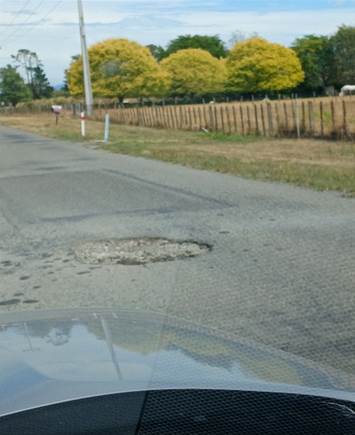
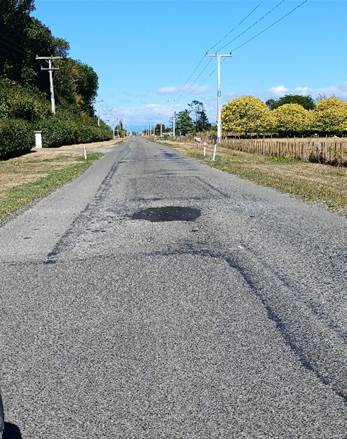
Pavement
repairs on Hughes line
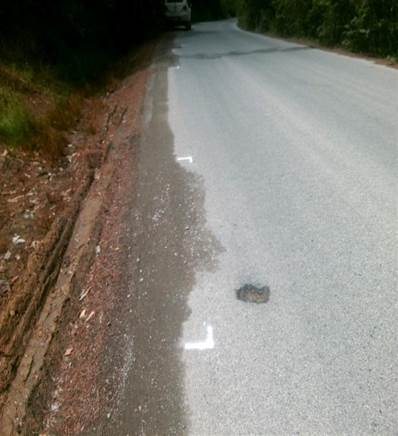

Edge
break repairs on Te Wharau Rd
4.2 Unsealed
road maintenance
Unsealed road maintenance is 76% spent in relation to Waka Kotahi
NZTA budgets.
Unsealed road inspection and grading were the major categories of
the job completed by the contractor. During January 2024 we graded 116 km of
unsealed roads. We also inspected 37 km of unsealed roads during in
January 2024.
4.3 Drainage
maintenance
Drainage Maintenance was 30% spent in relation to Waka Kotahi NZTA
budgets. We inspected 66 drainage assets on the network. We didn’t
do any drainage maintenance in January.
4.4 Structure’s
maintenance
The structure’s maintenance is 26% spent in relation to Waka
Kotahi NZTA budgets. In January, we inspected 10 bridges on Moffats Rd, Tea
Creek Rd, Matarawa Rd, Waiohine George Rd, Watersons Line, and Thomas Rd.
4.5 Environmental
maintenance
Environmental Maintenance is 43% spent in relation to Waka Kotahi
NZTA budgets. In January, there wasn’t any spillage on our roads.
4.6 Traffic
services Maintenance
Traffic services were 17.45% spent in relation to Waka Kotahi NZTA
budgets.
Sign inspection and asset data updating are continuing every month
and minor streetlight maintenance is continuing.
We inspected 82 signs on the network, and 3 signposts were replaced
on Te Kopi Road and Cobden Rd. One sign was replaced on Borlase Rd due to its
poor condition. All the activities including the asset health were updated in
the RAMM database.
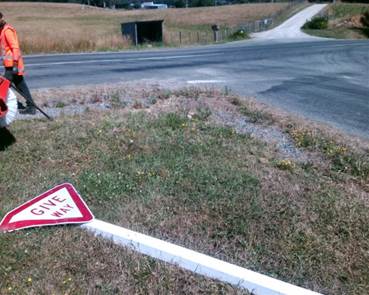
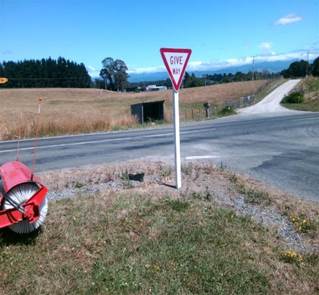
Sign post replaced on Te Kopi Rd
4.7 Footpath
maintenance
Footpath maintenance is 76% spent in relation to the Waka Kotahi
budget allocation.
In the January programme a pothole was repaired on a footpath on
Wyndham Rd.
CaPEX expenditure
Expenditure reports are again set against the Waka Kotahi budget
allocations which are approved for the financial year 2023/2024 and 24%
of the CAPEX budget spent.
4.8 Unsealed
Road Metaling
Unsealed Road Metaling was 25% spent in relation to the Waka Kotahi
NZTA budget allocation. No work was completed in this category in January 2024.
4.9 Drainage
renewals
Drainage Renewals was 41% spent in
relation to Waka Kotahi NZTA budget allocation.
No work was completed in this category in January 2024.
4.10 Pavement rehabilitation
Pavement rehabilitation was 9% spent in relation to the Waka Kotahi
NZTA budget allocation.
Pavement rehabilitation on Wiltons Road is planned for March 2024.
4.11 Traffic
service renewals
Traffic Service Renewals is 51% spent in relation to Waka Kotahi
NZTA budget allocation.
In January one sign was replaced on Park Road.
4.12 Footpath
renewal
Footpath Renewal is at 85% spent in relation to Waka Kotahi NZTA budget
allocation.
No work was completed in this category in January 2024.
4.13 Sealed
road resurfacing
Sealed Road surfacing is 86% spent in relation to Waka Kotahi NZTA
budget allocation. No seal road surfacing was undertaken in January.
4.14 Low-Cost
Low Risk (LCLR)
Longbush
Road and Millers Road Safety improvements
 The team is currently working with professional
service providers and contractors on options to improve the general road safety
and road user behaviour at the intersection. The concept under review will
include bringing a lane adjustment and raised concrete islands. The team is
optioneering a solution of not more than $50,000 to remain within existing
approved LCLR budgets.
The team is currently working with professional
service providers and contractors on options to improve the general road safety
and road user behaviour at the intersection. The concept under review will
include bringing a lane adjustment and raised concrete islands. The team is
optioneering a solution of not more than $50,000 to remain within existing
approved LCLR budgets.
LCLR Forward
works programme.
- Hughes Line
culvert extensions are planned for March 2024
- Wiltons Road
widening in March 2024 as part of the pavement rehabilitation work.
- Brooklyn
Road footpath extension to Lincoln Road April – June 2024.
4.15 Emergency
event works
More
Dropout repairs were completed on Te Wharau Rd and Clifton Grove. The team is
currently focusing on Glendburn Road which will be used as a detour when we are
doing repairs on Te Wharau between Glendburn and Flat Point Roads.
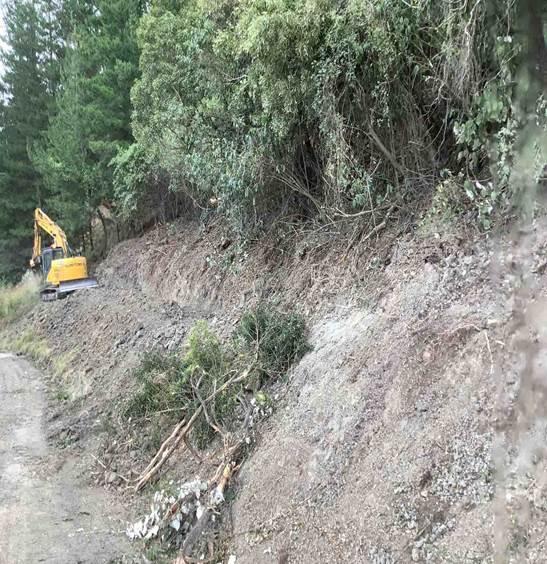
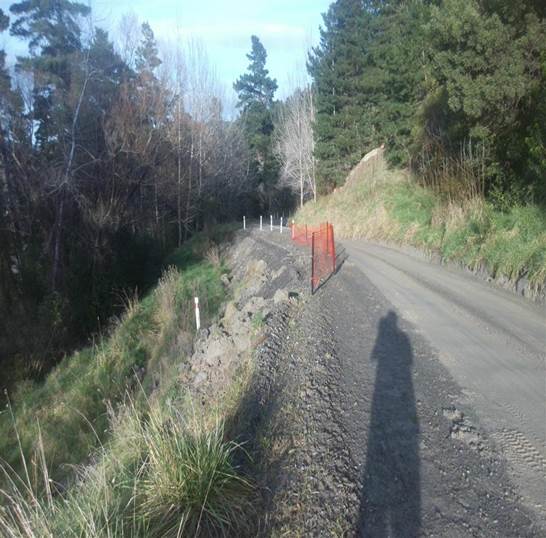
4.16 Service requests
In
January we received 18 Service requests for Roading.
4.17 Corridor
Access
In
January we received 17 corridor access requests (CAR) and issued 16 work access
permits (WAP).
Since
the introduction of the new fee structure for Corridor Access, we have managed
to recover most of our costs from private users. Historically this burden was
carried by rate payers.
|
Policy
and Projects Committee meeting Agenda
|
28
February 2024
|
4.18  Total Expenditure to date and Forecast
Total Expenditure to date and Forecast
|
Policy
and Projects Committee meeting Agenda
|
28
February 2024
|
5. CONSIDERATIONS
5.1 Climate change
This report does not have any
climate change implications.
5.2 Tāngata whenua
This
report is a regular update which is of interest to all members of our
community, including iwi and hapū. However, there are no particular areas
of interest or concern contained within this report that require specific iwi
or hapū input.
5.3 Financial impact
All
of the roading activities are completed under approved budgets, and this report
does not have any additional financial impacts.
5.4 Community Engagement requirements
There
are no additional community engagement requirements resulting from this report.
5.5 Risks
This
report is a regular update. It contains no specific or identified risks
which would require further attention or action.
6. Recommendation
That the Committee:
1. Receives
the report.
File
Number: 386581
Author: Johannes
Ferreira, Infrastructure Services Manager
Attachments: Nil
|
Policy
and Projects Committee meeting Agenda
|
28
February 2024
|

6.7 Resource
Consent Update
1. Purpose
The purpose of this
report is to update the Committee on the resource consents issued since the
previous update.
2. Significance
The
matters for decision in this report are not considered to be of significance
under the Significance and Engagement Policy.
3. Background
The
Terms of Reference for the Policy and Projects Committee include the oversight
of the implementation of the Wairarapa Combined District Plan. The
resource consents issued since the last report, from 11 November 2023 to 16
February 2024, are included in Attachment 1.
4. CONSIDERATIONS
4.1 Climate change
N/A
4.2 Tāngata whenua
N/A
4.3 Financial impact
N/A
4.4 Community Engagement requirements
Not applicable as
consultation requirements for resource consents are prescribed under section
95A-95B of the Resource Management Act 1991.
4.5 Risks
N/A
5. Recommendation
That the Committee:
1. Receives
the report.
File
Number: 385841
Author: Solitaire
Robertson, Planning and Regulatory Services Manager
Attachments: 1. Resource
Consents update to 16 Feb 2024 ⇩
|
Policy
and Projects Committee meeting Agenda
|
28
February 2024
|
